Mercedes-Benz A-CLASS SEDAN 2021 Driving and Parking User Manual
Introduction
With the beautiful Mercedes-Benz A-Class Sedan 2021, welcome to the world of luxury and performance! We will walk you through the amazing driving and parking experience that this magnificent car has to offer in this introduction. The Mercedes-Benz A-Class Sedan 2021 is a superb example of how elegance and innovation can coexist in harmony. As soon as you enter, you’ll notice the interior’s precise design, which features high-end materials and cutting-edge technology to enhance your driving experience.
The A-Class Sedan offers a variety of strong and effective engine choices under the hood, ensuring a dynamic driving experience that thrills and delights at every turn. This sedan offers a seamless and comfortable ride whether you’re traveling on vast highways or negotiating congested city streets. A sleek and technologically sophisticated car that provides a premium driving and parking experience is the Mercedes-Benz A-Class Sedan 2021. This sedan is made to give an exhilarating driving experience while providing convenience and comfort when it comes to parking thanks to its svelte design, powerful performance, and cutting-edge technology. You’ll notice the Mercedes-Benz A-Class Sedan 2021’s meticulous attention to design as soon as you get behind the wheel. In addition to enhancing its aesthetic appeal, the vehicle’s graceful lines and aerodynamic shape also improve its handling and stability when traveling. The sedan’s small dimensions and agile handling make it the perfect vehicle for negotiating congested city streets and confined parking spots with ease.
Driving and driving safety systems
Driving systems and your responsibility
Your vehicle is equipped with driving systems that assist you in driving, parking and maneuvering the vehicle. The driving systems are only aids. They are not a substitute for your attention to the surroundings and do not relieve you of your responsibility pertaining to road traffic law. The driver is always responsible for maintaining a safe distance to the vehicle in front, for vehicle speed, for braking in good time and for staying in lane. Pay attention to the traffic conditions at all times and intervene when necessary. Be aware of the limitations regarding the safe use of these systems.
Driving systems can neither reduce the risk of accident if you fail to adapt your driving style nor override the laws of physics. They cannot always take into account road, weather or traffic condi‐tions.
Information on vehicle sensors and cameras
Some driving and driving safety systems use cameras as well as radar or ultrasonic sensors to monitor the area in front of, behind or next to the vehicle.
The radar sensors are integrated behind the bumpers and/or behind the Mercedes star.
- Cameras in the outside mirrors
- Multifunction camera
- Front Camera
- Ultrasonic sensors
- Rearview camera
WARNING
Risk of accident due to restricted detection performance of vehicle sensors and cameras
If the area around vehicle sensors or cam‐eras is covered, damaged or dirty, certain driving and safety systems cannot function correctly. There is a risk of an accident.
- Keep the area around vehicle sensors or cameras clear of any obstructions and clean.
- Have damage to the bumper, radiator grille or stone chipping in the area of the front and rear windows repaired at a qualified specialist workshop.
Particularly, keep the areas around the sensors and cameras free of dirt, ice or slush. The sensors and cameras may not be covered and the detection ranges around them must be kept free. Do not attach additional license plate brackets, advertisements, stickers, foils or foils to protect against stone chippings in the detection range of the sensors and cameras. Make sure that there are no overhanging loads protruding into the detection range. If there is damage to a bumper or the radiator grille, or after an impact, have the function of the sensors checked at a qualified specialist workshop. Have damage or stone chipping in the area of the cameras on the windshield and rear window repaired at a qualified specialist workshop.
Overview of driving systems and driving safety systems
- ABS (Anti-lock Braking System)
- BAS (Brake Assist System)
- ESP® (Electronic Stability Program)
- ESP® Crosswind Assist
- EBD (Electronic Brakeforce Distribution)
- STEER CONTROL
- HOLD function
- Hill Start Assist
- Start-off assist
- ATTENTION ASSIST
- Cruise control
- Traffic Sign Assist
- Suspension with adaptive damping adjustment
Driving Assistance package
The following functions are part of the Driving Assistance Package. Certain functions are only available in some countries. Some functions are also available without the Driving Assistance Package, albeit with restricted functionality.
- Active Distance Assist DISTRONIC
- Active Speed Limit Assist (country-dependent)
- Route-based speed adaptation (country-dependent)
- Active Brake Assist
- Active Steering Assist (country-dependent)
- Active Emergency Stop Assist (country-dependent)
- Active Lane Change Assist (country-dependent)
- Blind Spot Assist and Active Blind Spot Assist with exit warning
- Active Lane Keeping Assist
Parking Package
- Rear view camera
- Surround view camera
- Parking Assist PARKTRONIC
- Active Parking Assist
The function of ABSThe Anti-lock Brake System (ABS) regulates the brake pressure in critical driving situations:
- During braking, e.g. at full brake application or insufficient tire traction, the wheels are prevented from locking.
- Vehicle steerability while braking is ensured.
If ABS intervenes when braking, you will feel a pulsing in the brake pedal. The pulsating brake pedal can be an indication of hazardous road conditions and can serve as a reminder to take extra care while driving.
The function of BASThe Brake Assist System (BAS) supports your emergency braking situation with additional brake force.
If you depress the brake pedal quickly, BAS is activated:
- BAS automatically boosts the brake pressure.
- BAS can shorten the braking distance.
- ABS prevents the wheels from locking.
The brakes will function as usual once you release the brake pedal. BAS is deactivated.
Functions of ESP® (Electronic Stability Program)
WARNING
Risk of skidding if ESP® is deactivated
If you deactivate ESP®, ESP® cannot carry out vehicle stabilization.
ESP® should only be deactivated in the following situations.
NOTE
Mercedes-AMG vehicles
Observe the notes in the Supplement. You could otherwise fail to recognize dangers.
ESP® can monitor and improve driving stability and traction in the following situations, within physical limits:
- When pulling away on wet or slippery road.
- When braking.
If the vehicle deviates from the direction desired by the driver, ESP® can stabilize the vehicle by intervening in the following ways:
- One or more wheels are braked.
- The engine output is adapted according to the situation.
ESP® is deactivated if theå ESP® OFF warning lamp lights up continuously in the instrument cluster.
Observe the following points when ESP® is deactivated:
- Driving stability will no longer be improved.
- The drive wheels could spin.
- ETS/4ETS traction control is still active.
- When ESP® is deactivated, you are still assisted by ESP® when braking.
If the ![]() ESP® warning lamp flashes in the instrument cluster, one or several wheels have reached its grip limit:
ESP® warning lamp flashes in the instrument cluster, one or several wheels have reached its grip limit:
- Adapt the driving style to suit the prevailing road and weather conditions.
- Do not deactivate ESP® under any circum‐ stances.
- Only depress the accelerator pedal as far as is necessary.
It may be best to deactivate ESP® in the following situations:
- When using snow chains.
- In deep snow.
- On sand or gravel.
- Spinning the wheels results in a cutting action, which enhances traction.
If the ![]() ESP® warning lamp lights up continuously, ESP® is not available due to a malfunction.
ESP® warning lamp lights up continuously, ESP® is not available due to a malfunction.
Observe the following information:
- Warning and indicator lamps
- Display messages
ETS/4ETS (Electronic Traction System)
ETS/4ETS traction control is part of ESP® and makes it possible to pull away and accelerate on a slippery road.
ETS/4ETS can improve the vehicle’s traction by intervening in the following ways:
- The drive wheels are braked individually if they spin.
- More drive torque is transferred to the wheel or wheels with traction.
Influence of Drive programs on ESP®
The drive programs enable ESP® to adapt to different weather and road conditions as well as the driver’s preferred driving style. Depending on the selected drive program, the appropriate ESP® mode will be activated. You can select the drive programs using the DYNAMIC SELECT switch.
The function of ESP® Crosswind Assist
ESP® Crosswind Assist detects sudden gusts of side wind and helps the driver to keep the vehicle in the lane:
- ESP® Crosswind Assist is active at vehicle speeds between approx. 47 mph (75 km/h) and 125 mph (200 km/h) when driving straight ahead or cornering slightly.
- The vehicle is stabilized by means of individual brake application on one side.
Activating/deactivating ESP® (Electronic Stability Program)
ESP® can only be activated/deactivated using quick access when at least one other function is available in quick access. ESP® can otherwise be found in the Assistance menu.
NOTE
Mercedes-AMG vehicles
Observe the notes in the Supplement. You could otherwise fail to recognize dangers.
- Select ESP.
- Select On or
 Off.
Off.
ESP® is deactivated if the![]() ESP® OFF warning lamp lights up continuously in the instrument cluster.
ESP® OFF warning lamp lights up continuously in the instrument cluster.
Observe the information on warning lamps and display messages which may be shown in the instrument cluster.
Function of EBD
Electronic Brakeforce Distribution (EBD) is characterized by the following:
- Monitoring and regulating the brake pressure on the rear wheels.
- Improved driving stability when braking, especially on bends.
The function of STEER CONTROL
STEER CONTROL helps you by transmitting a noticeable steering force to the steering wheel in the direction required for vehicle stabilization.
This steering recommendation is given in the following situations:
- Both right wheels or both left wheels are on a wet or slippery road surface when you brake
- The vehicle starts to skid
System limits
STEER CONTROL may be impaired or may not function in the following situations:
- ESP® is deactivated.
- ESP® is malfunctioning.
- The steering is malfunctioning.
If ESP® is malfunctioning, you will be assisted further by the electric power steering.
HOLD function
The HOLD function holds the vehicle at a standstill without requiring you to depress the brake pedal, e.g. while waiting in traffic.
The HOLD function is only an aid. The responsibility for the vehicle safely standing still remains with the driver.
System limits
The HOLD function is only intended to provide assistance when driving and is not a sufficient means of safeguarding the vehicle against rolling away when stationary.
The incline must not be greater than 30%.
Activating/deactivating the HOLD function
WARNING
Risk of an accident due to the HOLD function being active when you leave the vehicle
If the vehicle is only braked with the HOLD function it could, in the following situations, roll away:
- If there is a malfunction in the system or in the power supply.
- If the HOLD function is deactivated by depressing the accelerator pedal or brake pedal, e.g. by a vehicle occupant.
- Always secure the vehicle against roll‐ing away before you leave it.
Requirements:
- The vehicle is stationary.
- The driver’s door is closed or the seat belt on the driver’s side is fastened.
- The engine is running or has been automatically switched off by the ECO start/stop function.
- The electric parking brake is released.
- Active Distance Assist DISTRONIC is deactivated.
- Vehicles with automatic transmission:
The transmission is in position h, k or i
Activating the HOLD function
- Depress the brake pedal, and after a short time quickly depress further until theë display appears in the multifunction display.
- Release the brake pedal.
Deactivating the HOLD function
- Depress the accelerator pedal to pull away.
- Depress the brake pedal until theë display disappears from the multifunction display.
The HOLD function is deactivated in the following situations:
- Active Distance Assist DISTRONIC is activated.
- Vehicles with automatic transmission:
The transmission is switched to position j. - The vehicle is secured with the electric parking brake.
In the following situations, the vehicle is held by transmission position j and/or by the electric parking brake:
- The seat belt is unfastened and the driver’s door is opened.
- The vehicle is switched off.
- There is a malfunction in the system or the power supply is insufficient.
Function of Hill Start Assist
Hill Start Assist holds the vehicle for a short time when pulling away on a hill under the fol‐lowing conditions:
- Vehicles with automatic transmission:
The transmission is in position h or k. - The electric parking brake is released.
This gives you enough time to move your foot from the brake pedal to the accelerator pedal and depress it before the vehicle begins to roll away.
WARNING
Risk of accident and injury due to the vehicle rolling away
After a short time, Hill Start Assist no longer holds the vehicle.
Swiftly move your foot from the brake pedal to the accelerator pedal. Do not leave the vehicle when it is being held by Hill Start Assist.
Start-off assist
Function of the start-off assist
The start-off assist enables optimal vehicle acceleration from a standstill. For this, a suitably high-grip road surface is required, the tires and vehicle must also be in good condition.
Do not activate the start-off assist on public roads. Be sure to observe the safety notes and informa‐tion on ESP®.
Activating the start-off assist
WARNING
Risk of skidding and having an accident from wheels spinning
When you use start-off assist, individual wheels could spin and you could lose control of the vehicle.
If ESP® is deactivated, there is a risk of skidding and accident:
- Make sure that no persons or obstacles are in the close vicinity of your vehicle.
- Deactivating ESP®.
- Move the steering wheel to the straight-ahead position.
- Depress the brake pedal firmly with your left foot and keep it depressed.
- Engage the h drive position.
- Select the sportiest available drive program B or C.
- Rapidly depress the accelerator pedal fully.
- Take your foot off the brake, but keep the accelerator pedal depressed.
The vehicle pulls away at maximum acceleration. - Switch on ESP® once the acceleration procedure is complete. ESP® will otherwise not be able to stabilize the vehicle if the vehicle starts to skid or a wheel starts to spin.
Canceling the start-off assist
- Remove your foot from the accelerator pedal.
- Reactivate the ESP®.
ATTENTION ASSIST
Function of ATTENTION ASSIST
ATTENTION ASSIST assists you on long, monoto‐nous journeys, e.g. on highways and trunk roads. If ATTENTION ASSIST detects indicators of fati‐gue or increasing lapses in concentration on the part of the driver, it suggests taking a break. ATTENTION ASSIST is only an aid. It cannot always detect fatigue or lapses in concentration in time. The system is not a substitute for a wellrested and attentive driver. On long journeys, take regular breaks in good time that allow for adequate recuperation.
You can choose between two settings:
- Standard: normal system sensitivity.
- Sensitive: higher system sensitivity. The driver is warned earlier and the attention level detected by ATTENTION ASSIST is adap‐ted accordingly.
If drowsiness or increasing lapses in concentra‐tion are detected, the ATTENTION ASSIST: Take a Break! warning appears in the Instrument Dis‐
play. You can acknowledge the message and take a break where necessary. If you do not take a break and ATTENTION ASSIST continues to detect increasing lapses in concentration, you will be warned again after a minimum of 15 minutes.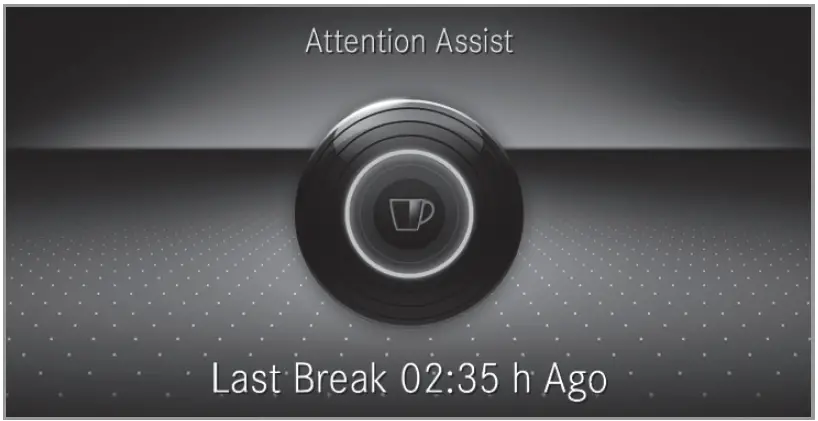
You can have the following status information for ATTENTION ASSIST displayed in the assistance menu of the on-board computer:
- The length of the journey since the last break.
- The attention level determined by ATTENTION ASSIST:
- The fuller the circle, the higher the atten‐tional level determined
- As your attention wanes, the circle in the center of the display becomes smaller
If ATTENTION ASSIST is unable to calculate the attention level and cannot issue a warning, the System Suspended message appears. If a warning is given in the Instrument Display, the multimedia system offers to search for a rest area. You can select a rest area and start naviga‐tion to this rest area. This function can be activa‐ted and deactivated in the multimedia system.
If ATTENTION ASSIST is deactivated, the ![]() symbol appears in the assistance graphic in the Instrument Display when the engine is running.
symbol appears in the assistance graphic in the Instrument Display when the engine is running.
ATTENTION ASSIST is activated automatically when the engine is re-started. The last selected sensitivity level remains stored.
System limits
ATTENTION ASSIST is active in the 37 mph (60 km/h) to 124 mph (200 km/h) speed range.
Particularly in the following situations, ATTENTION ASSIST only functions in a restricted man‐ner and warnings may be delayed or not occur:
- If you have been driving for less than approximately 30 minutes.
- If the road condition is poor (uneven road surface or potholes).
- If there is a strong side wind.
- If you adopt a sporty driving style (high cornering speeds or high rates of acceleration).
- If the Steering Assist function of Active Distance Assist DISTRONIC is active.
- If the time has been set incorrectly.
- If you change lanes and vary your speed frequently In active driving situations.
The ATTENTION ASSIST drowsiness or alertness assessment is reset and restarted when continuing the journey in the following situations:
- If you switch off the engine.
- If you unfasten your seat belt and open the driver’s door (e.g. to change drivers or take a break).
Setting options
- Select Standard, Sensitive or Off.
Suggesting a rest area
- Select Suggest Rest Area.
- Activate or deactivate the function.
If ATTENTION ASSIST detects fatigue or an increasing lack of attention, it suggests a rest area in the vicinity. - Select the suggested rest area.
You are guided to the selected rest area.
Speed control cruise control
The function of cruise control
Cruise control regulates the speed to the value selected by the driver.
If you accelerate to overtake, for example, the stored speed is not deleted. If you remove your foot from the accelerator pedal after overtaking, cruise control will resume speed regulation back to the stored speed.
You can store any speed above 15 mph (20 km/h) up to the maximum design speed. Observe the notes on driving systems and your responsibility; you may otherwise fail to recognize dangers.
Mercedes‑AMG vehicles: Cruise control is available up to a maximum speed of 155 mph (250 km/h).
Displays on the multifunction display
 (gray): cruise control is selected but not yet activated.
(gray): cruise control is selected but not yet activated. (green): cruise control is active.
(green): cruise control is active.
A stored speed appears along with the![]() dis‐play.
dis‐play.
The segments between the stored speed and the end of the segment display light up in the speedometer.
System limits
Cruise control may be unable to maintain the stored speed on uphill gradients. The stored speed is resumed when the gradient evens out.
Change into a lower gear in good time on long and steep downhill gradients. Take particular note of this when driving a laden vehicle. By doing so, you will make use of the engine’s brak‐ing effect. This relieves the load on the brake system and prevents the brakes from overheat‐ing and wearing too quickly.
Do not use cruise control in the following situa‐tions:
- In traffic situations which require frequent changes of speed, e.g. in heavy traffic, on winding roads.
- On slippery roads. Accelerating can cause the drive wheels to lose traction and the vehicle could then skid.
- If you are driving when visibility is poor.
Operating cruise control
WARNING
Risk of accident due to stored speed
If you call up the stored speed and this is lower than your current speed, the vehicle decelerates.
Take into account the traffic situation before calling up the stored speed.
Requirements:
- ESP® must be activated, but not intervening.
- The vehicle speed is at least 15 mph (20 km/h).
- The transmission is in position h.
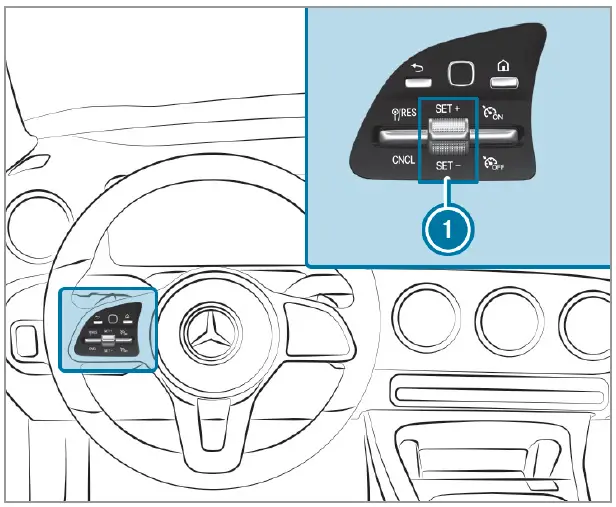
Operating cruise control
Press the rocker switches on the steering wheel control panel up or down to the desired position.
Activating cruise control
Select ![]() with the right rocker switch.
with the right rocker switch.
Activating cruise control
- Press rocker switches 1 up
 or down
or down 
The current speed is stored and maintained by the vehicle. - Select J with the left rocker switch. The last stored speed is called up and maintained by the vehicle.
If the last stored speed has previously been deleted, the current vehicle speed is stored. - When you switch off the vehicle, the last speed stored is deleted.
Increasing or decreasing the stored speed
- 1 mph (1 km/h): press rocker switch 1 up
 or down
or down  to the pressure point.
to the pressure point. - 5 mph (10 km/h): press rocker switch 1 up
 or down
or down beyond the pressure point.
beyond the pressure point. - Accelerate the vehicle to the desired speed and press rocker switch 1 up
 .
.
Adopting a detected speed
- Activate cruise control.
- If a traffic sign has been detected and is displayed in the instrument cluster: select
 with the left rocker switch.
with the left rocker switch.
The maximum permissible speed shown by the traffic sign is stored and the vehicle maintains or does not exceed this speed.
Deactivating cruise control
Select O with the left rocker switch.
Switching off the cruise control
Select with the right rocker switch.
If you brake, deactivate ESP® or if ESP® intervenes, cruise control is deactivated.
Active Distance Assist DISTRONIC
The function of Active Distance Assist DISTRONIC
Active Distance Assist DISTRONIC maintains the set speed on free-flowing roads. If vehicles in front are detected, the set distance is maintained, if necessary, until the vehicle comes to a halt. The vehicle accelerates or brakes depending on the distance to the vehicle in front and the set speed. The speed and distance to the vehicle in front are set and saved using the steering wheel.
Available speed range:
- Vehicles without Driving Assistance Pack‐age: 15 mph (20 km/h) – 120 mph (200 km/h)
- Vehicles with Driving Assistance Pack‐age: 15 mph (20 km/h) – 130 mph (210 km/h)
Other features of Active Distance Assist DISTRONIC:
- Adjusts the driving style depending on the selected drive program (fuel-saving, comfort‐able or dynamic)
- Initiates acceleration to the stored speed if the turn signal indicator is switched on to change to the overtaking lane
- Vehicles with Driving Assistance Package:
- Reacts to stationary vehicles detected in urban speed ranges (except bicycles and motorcycles)
- Takes one-sided overtaking restrictions into account on highways or on multi-lane roads with separate roadways (country-dependent)
Vehicles with Driving Assistance Package and Parking Package:
if the vehicle has been braked to a standstill on multi-lane, separate roadways by Active Distance Assist DISTRONIC, it can automatically follow the vehicle in front driving off again within 30 seconds. If a critical situation is detected when driving off, a visual and acoustic warning is given indicating that the driver must now take control of the vehicle. The vehicle is not accelerated any further.
Observe the notes on driving systems and your responsibility; you may otherwise fail to recog‐nize dangers.
Active Distance Assist DISTRONIC displays in the instrument cluster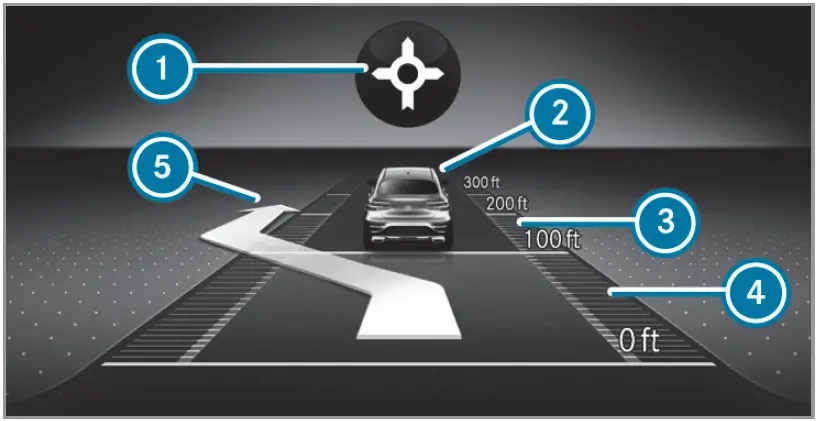
Assistance display
- Route-based speed adaptation: type of route event
- Vehicle in front
- Distance indicator
- Set specified distance
- Active Lane Change Assist lane change display
Permanent status display of Active Distance Assist DISTRONIC
 (white): Active Distance Assist DISTRONIC selected, specified distance set
(white): Active Distance Assist DISTRONIC selected, specified distance set (white vehicle, green speedometer):
(white vehicle, green speedometer):
Active Distance Assist DISTRONIC active, specified distance set and vehicle detected (green): Active Distance Assist DISTRONIC active, specified distance set, and vehicle detected
(green): Active Distance Assist DISTRONIC active, specified distance set, and vehicle detected Route-based speed adaptation active.
Route-based speed adaptation active.
The stored speed is shown along with the permanent status display and highlighted on the speedometer. When Active Distance Assist DISTRONIC is passive, the speed is grayed out.- On highways or high-speed major roads, the green
 vehicle symbol is displayed cyclically when the vehicle is ready to pull away.
vehicle symbol is displayed cyclically when the vehicle is ready to pull away. - If you depress the accelerator pedal beyond the setting of the Active Distance Assist DISTRONIC, the system is switched to passive mode. The
 Suspended message appears in the multifunction display.
Suspended message appears in the multifunction display.
Display on the speedometer
The stored speed is highlighted on the speedometer. If the speed of the vehicle in front or the speed adjustment is less than the stored speed due to the route event ahead, the segments in the speedometer light up. Deactivation of Active Distance Assist DISTRONIC, as well as alterations to the speed due to manual or automatic adoption of the maximum permissible speed, are displayed in the control feedback of the multi‐function display on a single line.
System limits
The system may be impaired or may not function in the following situations, for example:
- In snow, rain, fog, heavy spray, if there is glare, in direct sunlight or in greatly varying ambient light.
- The windshield in the area of the camera is dirty, fogged up, damaged or covered.
- If the radar sensors are dirty or covered.
- In parking garages or on roads with steep uphill or downhill gradients.
- If there are narrow vehicles in front, such as bicycles or motorcycles.
In addition, on slippery roads, braking or accelerating can cause one or several wheels to lose traction and the vehicle could then skid.
Do not use Active Distance Assist DISTRONIC in these situations.
WARNING
Risk of accident from acceleration or braking by Active Distance Assist DISTRONIC
Active Distance Assist DISTRONIC may accel‐erate or brake in the following cases, for example:
- If the vehicle pulls away using Active Distance Assist DISTRONIC.
- If the stored speed is called up and is considerably faster or slower than the currently driven speed.
- If Active Distance Assist DISTRONIC no longer detects a vehicle in front or does not react to relevant objects.
- Always carefully observe the traffic con‐ditions and be ready to brake at all times.
- Take into account the traffic situation before calling up the stored speed.
WARNING
Risk of accident due to insufficient deceleration by Active Distance Assist DISTRONIC
Active Distance Assist DISTRONIC brakes your vehicle with up to 50% of the possible deceleration. If this deceleration is not suffi‐cient, Active Distance Assist DISTRONIC alerts you with a visual and acoustic warning.
- Adjust your speed and maintain a suitable distance from the vehicle in front.
- Brake the vehicle yourself and/or take evasive action.
WARNING
Risk of accident if detection function of Active Distance Assist DISTRONIC is impaired
Active Distance Assist DISTRONIC does not react or has a limited reaction:
- when driving on a different lane or when changing lanes
- to pedestrians, animals, bicycles or stationary vehicles, or unexpected obstacles
- to complex traffic conditions
- to oncoming vehicles and crossing traffic
As a result, Active Distance Assist DISTRONIC may neither give warnings nor intervene in such situations.
Always observe the traffic conditions carefully and react accordingly.
Operating Active Distance Assist DISTRONIC
Requirements:
- The electric parking brake is released.
- ESP® is activated and is not intervening.
- The transmission is in position h.
- The driver’s door is closed.
- Check of the radar sensor system has been successfully completed.
- Parking Assist PARKTRONIC is not being used to park the vehicle or to exit from a parking space.
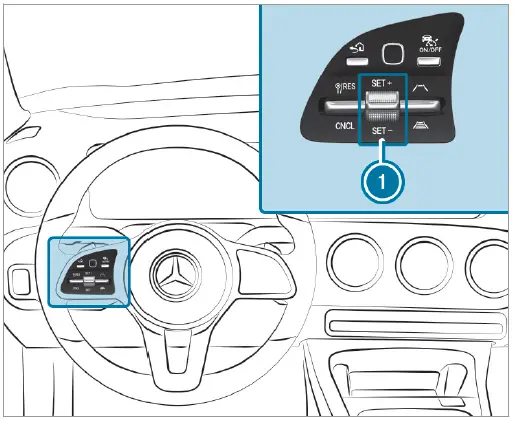
To operate Active Distance Assist
DISTRONIC: press the rocker switches on the steering wheel control unit up or down to the desired position.
Activating/deactivating Active Distance Assist DISTRONIC
- Press the button.
Activating Active Distance Assist DISTRONIC - To activate with a stored speed: select J with the left rocker switch.
- Remove your foot from the accelerator pedal.
The current speed is stored and maintained by the vehicle.
Adopting a detected speed limit - Activate Active Distance Assist DISTRONIC.
- If a traffic sign has been detected and is dis‐played in the instrument cluster: select J with the left rocker switch.
The maximum permissible speed on the traf‐fic sign is adopted as the stored speed. The vehicle adapts its speed to that of the vehicle in front, but only up to the stored speed.
Pulling away with Active Distance Assist DISTRONIC
- Activate Active Distance Assist DISTRONIC and remove your foot from the brake pedal.
- Select
 with the left rocker switch.
with the left rocker switch. - Depress the accelerator pedal briefly and firmly.
The functions of Active Distance Assist DISTRONIC continue to be carried out.
Deactivating Active Distance Assist DISTRONIC
WARNING
Risk of an accident due to Active Distance Assist DISTRONIC being active when you leave the driver’s seat
If you leave the driver’s seat while the vehicle is being braked by Active Distance Assist DISTRONIC only, the vehicle can roll away.
Always deactivate Active Distance Assist DISTRONIC and secure the vehi‐cle to prevent it from rolling away before you leave the driver’s seat.
Increasing or decreasing the speed
- 1 mph (1 km/h): press rocker switch 1 up
 or down
or down to the pressure point.
to the pressure point. - 5 mph (10 km/h): press rocker switch 1 up
 or down
or down beyond the pressure point.
beyond the pressure point. - Accelerate the vehicle to the desired speed and press rocker switch 1 up

Changing the specified distance to the vehicle in front
- To reduce the specified distance: press the right rocker switch up (
 ).
). - To increase the specified distance: press the right rocker switch down (
 ).
).
Function of Active Speed Limit Assist
If speed limit change between 12 mph (20 km/h) and 80 mph (130 km/h) is detected and the automatic adoption of speed limits is active, it will be automatically adopted as the stored speed (/ page 179).
The driven speed is adjusted when the vehicle is level with the traffic sign at the latest. In the case of signs indicating entry into an urban area, the speed is adapted according to the speed permitted within the urban area. The speed limit display in the Instrument Display is always upda‐ted when the vehicle is level with the traffic sign.
If there is no speed restriction on an unlimited stretch of road (e.g. on a freeway), the recom‐mended speed is automatically adopted as the stored speed. The system uses the speed stored on an unlimited stretch of road as the recommended speed. If you do not alter the stored speed on an unlimited stretch of road, the rec‐ommended speed is 80 mph (130 km/h). If Active Distance Assist DISTRONIC has been put into passive mode by pressing the accelerator pedal, only speed limits which are higher than the set speed are adopted. Observe the notes on driving systems and your responsibility; you may otherwise fail to recog‐nize dangers.
System limits
The system limits of Traffic Sign Assist apply to the detection of traffic signs.
Speed limits below 12 mph (20 km/h) are not automatically adopted by the system as the stored speed. Temporary speed restrictions (e.g. for a certain time or due to weather conditions) cannot be properly detected by the system. The maximum permissible speed applying to a vehi‐cle with a trailer is not detected by the system. Adjust the speed in these situations.
WARNING
Risk of accident due to Active Speed Limit Assist adapting the vehicle’s speed
The speed adopted by Active Speed Limit Assist may be too high or incorrect in some individual cases, such as:
- at speed limits below 12 mph (20 km/h) R in wet conditions or in fog
- when towing a trailer
- Ensure that the driven speed complies with traffic regulations.
- Adjust the driving speed to suit current
Function of route-based speed adaptation
When Active Distance Assist DISTRONIC is acti‐vated, the vehicle speed will be adapted accord‐ingly to the route events ahead. Depending on the drive program selected, the vehicle negotiates a route event ahead in an economical, com‐fortable or dynamic manner. When the route event has been passed, the vehicle accelerates again to the stored speed. The set distance to the vehicle in front, vehicles detected ahead and speed restrictions ahead are taken into account.You can activate and deactivate route-based speed adaptation in the multimedia system.
The following route events are taken into account:
- Curves
- T-intersections, roundabouts and toll stations
- Turns and exits
- Traffic jams ahead (only with Live Traffic Information )
- When the toll station is reached, Active Distance Assist DISTRONIC adopts the speed as the stored speed.
Also, the speed is reduced if the turn signal indi‐cator to change lanes is switched on and one of the following situations is detected:
- Turning off at intersections
- Driving on slowing-down lanes
- Driving on lanes adjacent to slowing-down lanes
The driver is responsible for choosing the right speed and observing other road users. This applies in particular to intersections, round‐abouts and traffic lights, as route-based speed adaptation does not brake the vehicle to a stand‐still. When route guidance is active, the first speed adjustment is carried out automatically. If the turn signal indicator is switched on, the selected route is confirmed and further speed adjustment is activated.
Speed adaptation is canceled in the following cases:
- If the turn signal indicator is switched off before the route event.
- If the driver depresses the accelerator or brake pedal during the process.
System limits
Route-based speed adaptation does not take right of way regulations into account. The driver is responsible for complying with road traffic regulations and driving at a suitable speed.
The speed adaptation made by the system may not always be suitable, particularly in the following situations:
- The road’s course not clearly visible
- Road narrowing
- Varying maximum permissible speeds in individual lanes
- Wet road surfaces, snow or ice
In these situations, the driver must intervene accordingly.
WARNING
Risk of an accident in spite of route-based speed adaptation
Route-based speed adaptation can malfunction or be temporarily unavailable in the following situations:
- If the driver does not follow the calculated route
- If map data is not up-to-date or available
- In the event of roadworks
- In bad weather or road conditions
- If the accelerator pedal is depressed R In the event of electronically displayed speed limitations
- Adapt the speed to the traffic situation.
Setting route-based speed adaptation
Requirements:
- Active Distance Assist DISTRONIC is activated.
- ECO Assist is active.
Multimedia system:
Activate or deactivate the function. When the function is active, the vehicle speed is adjusted depending on the route events ahead.
Active Steering Assist
Function of Active Steering Assist
Active Steering Assist is only available up to a speed of 130 mph (210 km/h). The system helps you to stay in the center of the lane by means of moderate steering interventions. Depending on the speed driven, Active Steering Assist uses the vehicles ahead and lane markings as a refer‐ence.
Depending on the country, in the lower speed range Active Steering Assist can use the surrounding traffic as a reference. If nec‐essary, Active Steering Assist can then also provide assistance when driving away from the center of the lane, for example, to form a rescue lane. If the detection of lane markings and vehicles ahead is impaired, Active Steering Assist switches to passive mode. The system provides no support in this case.
Status display of Active Steering Assist in the multifunction display
 (gray): activated and passive
(gray): activated and passive (green): activated and active
(green): activated and active (red): system limits detected
(red): system limits detected (white, red hands): “hands on the steering wheel” prompt
(white, red hands): “hands on the steering wheel” prompt- During the transition from active to passive status, the
 symbol is shown as enlarged and flashing. Once the system is passive, the
symbol is shown as enlarged and flashing. Once the system is passive, the symbol is shown as gray in the multifunction display.
symbol is shown as gray in the multifunction display. - Depending on the selected vehicle settings, Active Steering Assist may be unavailable.
Steering and touch detection
The driver is required to keep their hands on the steering wheel at all times and be able to intervene at any time to correct the course of the vehicle and keep it in lane. The driver must expect a change from active to passive mode or vice versa at any time.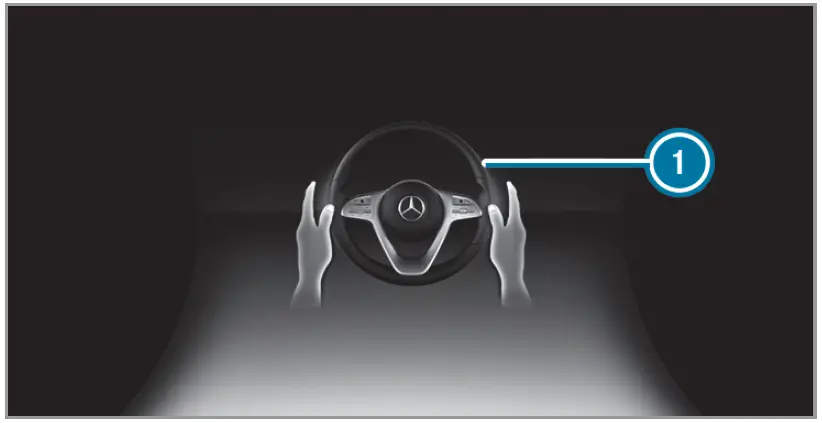
If the system detects that the driver has not steered the vehicle for a considerable period of time or has removed their hands from the steering wheel, display 1 appears. If the driver still does not steer the vehicle, a warning tone sounds in addition to the visual warning message. If the driver does not react to the warning for a considerable period, the system can initiate an emergency stop.
The warning is not issued or is stopped when the driver gives confirmation to the system:
- The driver steers the vehicle.
- Depending on the country: the driver presses a steering wheel button or operates Touch Control
If Active Steering Assist detects that a system limit has been reached, a visual warning is issued and a warning tone sounds.
Observe the notes on driving systems and your responsibility; you may otherwise fail to recognize dangers.
System limits
Active Steering Assist has a limited steering tor‐que for lateral guidance. In some cases, the steering intervention is not sufficient to keep the vehicle in the lane or to drive through exits.
The system may be impaired or may not function in the following instances:
- There is poor visibility, e.g. due to snow, rain, fog, heavy spray, greatly varying ambient light or strong shadows on the road.
- There is glare, e.g. from oncoming traffic, direct sunlight or reflections.
- Insufficient road illumination.
- The windshield is dirty, fogged up, damaged or covered in the vicinity of the camera, e.g. by a sticker.
- No, or several, unclear lane markings are present for one lane, or the markings change quickly, for example, in a construction area or at intersections.
- The lane markings are worn away, dark or covered up, e.g. by dirt or snow.
- If the distance to the vehicle in front is too short and thus the lane markings cannot be detected.
- The road is narrow and winding.
- There are obstacles on the lane or projecting out into the lane, such as object markers.
The system does not provide assistance in the following conditions:
- On tight curves and when turning.
- When crossing intersections.
- At roundabouts or toll plazas.
- When the tire pressure is too low.
If the system limits of Active Steering Assist are reached there is no guarantee that the system will remain active or will keep the vehicle in lane.
- Always keep your hands on the steering wheel and observe the traffic carefully.
- Always steer the vehicle paying attention to traffic conditions.
WARNING
Risk of accident if Active Steering Assist unexpectedly intervenes
The detection of lane markings and objects may malfunction and cause unexpected steering interventions.
Function of Active Emergency Stop Assist
If the system detects that the driver has not steered the vehicle for a considerable period of time or has removed their hands from the steer‐ing wheel, display 1 appears in the multifunc‐tion display. If the driver still does not steer the vehicle, or gives no confirmation to the system, a warning tone sounds in addition to the visual warning message.
If the driver still does not respond to the warn‐ing, the Beginning Emergency Stop message appears in the multifunction display. If the driver still does not respond, Active Distance Assist DISTRONIC reduces the speed. The vehicle is decelerated in stages to a standstill. Depending on the country, at speeds below 40 mph (60 km/h) the hazard warning lights switch on automatically.
When the vehicle is stationary, the following actions are carried out:
- The vehicle is secured with the electric parking brake.
- Active Distance Assist DISTRONIC is ended
- The vehicle is unlocked.
- If possible, an emergency call is placed to the Mercedes-Benz emergency call center
The driver can cancel the deceleration at any time by performing one of the following actions:
- Steering
- Braking or accelerating
- Deactivating Active Distance Assist DISTRONIC
Active Lane Change Assist
Function of Active Lane Change Assist
Active Lane Change Assist supports the driver when changing lanes by applying steering torque if the driver operates a turn signal indicator.
Observe the notes on driving systems and your responsibility; you may otherwise fail to recognize dangers.
Assistance when changing lanes is provided if all the following conditions are met:
- You are driving on a freeway or road with multiple lanes in the direction of travel.
- The neighboring lane is separated by a broken lane marking.
- No vehicle is detected in the adjacent lane.
- The vehicle speed is between 50 mph (80 km/h) and 110 mph (180 km/h).
- Active Lane Change Assist is switched on in the multimedia system.
- Active Steering Assist is activated and active.
If no vehicle is detected in the adjacent lane and a lane change is permitted, the lane change begins after the driver has activated the turn signal indicator. This is shown to the driver with a green arrow next to the± steering wheel symbol. The Lane Change to the Left message, for example, also appears. If Active Lane Change Assist has been activated with the turn signal indicator but a lane change is not immediately possible, a gray arrow appears next to the± steering wheel symbol, which remains green. When the lane change assistance starts, the turn signal indicator is automatically activated along with the display in the multifunction display. If the assistance graphic is shown when changing lanes, an additional arrow appears in it pointing towards the adjacent lane.
If a lane change is not possible, the arrow is faded out after a few seconds and a new lane change must be initiated. An immediate lane change is only possible on freeway sections without speed limits.
If the system is impaired, Active Lane Change Assist may be canceled. If it is canceled, the Lane Change Canceled message appears in the multifunction display.
In addition, a warning tone may sound, depend‐ing on the situation.
WARNING
Risk of accident when changing lane to an occupied adjacent lane
Lane Change Assist cannot always clearly detect if the adjacent lane is free.
The lane change might be initiated although the adjacent lane is not free.
- Before changing lanes, make sure that the neighboring lane is free and there is no danger to other road users.
- Monitor the lane change.
WARNING
Risk of accident if Lane Change Assist unexpectedly stops functioning
If the system limitations for Lane Change Assist have been reached, there is no guar‐antee that the system will remain active.
Lane Change Assist cannot then assist you by applying steering torque.
- Always monitor the lane change and keep your hands on the steering wheel. Observe the traffic conditions and steer and/or brake if necessary.
System limits
The system limitations of Active Steering Assist apply to Active Lane Change Assist.
The system may also be impaired or may not function in the following situations:
- The sensors in the rear bumper are dirty, damaged or covered by a sticker or ice and snow, for example.
- The exterior lighting shows a malfunction.
- The Active Lane Change Assist sensors adjust automatically while a certain distance is being driven after the vehicle has been delivered. Active Lane Change Assist is unavailable or only partially available during this teach-in process; no arrow appears next to theØ Active Steering Assist symbol when the turn signal indicator is activated.
Active Brake Assist
Function of Active Brake Assist
Active Brake Assist consists of the following functions:
- Distance warning function
- Autonomous braking function
- Situation-dependent braking assistance
- Vehicles with Driving Assistance Package: Evasive Steering Assist and Cornering function
Active Brake Assist can help you to minimize the risk of a collision with vehicles, cyclists or pedestrians or to reduce the effects of such a collision.
If Active Brake Assist has detected a risk of collision, a warning tone sounds and theL distance warning lamp lights up in the instrument cluster.
Vehicles with PRE-SAFE®:
depending on the country, an additional haptic warning occurs in the form of slight, repeated tensioning of the seat belt.
If you do not react to the warning, autonomous braking can be initiated in critical situations. In especially critical situations, Active Brake Assist can initiate autonomous braking directly. In this case, the warning lamp and warning tone occur simultaneously with the braking applica‐tion. If you apply the brake yourself in a critical situa‐tion or apply the brake during autonomous brak‐ing, situation-dependent braking assistance occurs. The brake pressure increases up to max‐imum full-stop braking if necessary. Observe the notes on driving systems and your responsibility; you may otherwise fail to recog‐nize dangers.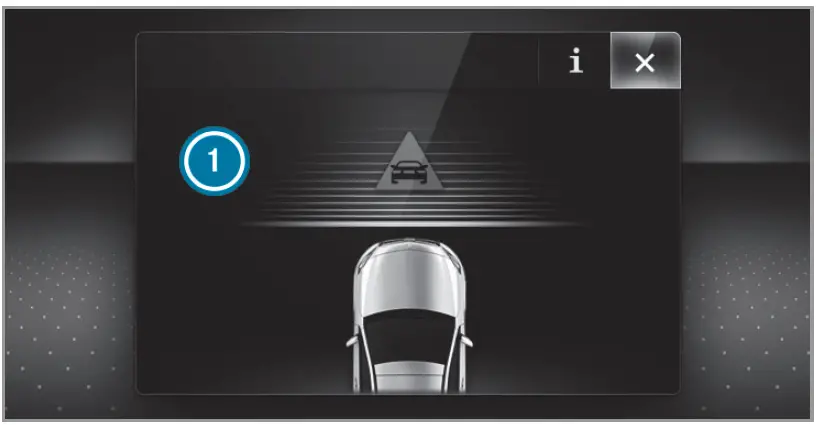
If autonomous braking or situation-dependent braking assistance has occurred, display 1 appears in the multifunction display and then automatically goes out after a short time.
If the autonomous braking function or the situation-dependent braking assistance is triggered, additional preventive measures for occupant protection (PRE-SAFE®) may also be initiated.
WARNING
Risk of an accident caused by limited detection performance of Active Brake Assist
Active Brake Assist cannot always clearly identify objects and complex traffic situations.
- Always pay careful attention to the traffic situation; do not rely on Active Brake Assist alone. Active Brake Assist is only an aid. The driver is responsible for maintaining a sufficiently safe distance to the vehicle in front, vehicle speed and for braking in good time.
- Be prepared to brake or swerve if necessary.
Also observe the system limits of Active Brake Assist.
The individual subfunctions are available in various speed ranges:
The distance warning function can issue a warn‐ing in the following situations:
- From approximately 4 mph (7 km/h), if your vehicle is critically close to a vehicle, cyclist or pedestrian, you will hear an intermittent warning tone and the
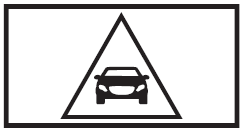 distance warning lamp lights up in the instrument cluster. Vehicles with PRE-SAFE®: depending on the country, an additional haptic warning occurs in the form of slight, repeated tensioning of the seat belt.Brake immediately or take evasive action, provided it is safe to do so and the traffic situation allows this.
distance warning lamp lights up in the instrument cluster. Vehicles with PRE-SAFE®: depending on the country, an additional haptic warning occurs in the form of slight, repeated tensioning of the seat belt.Brake immediately or take evasive action, provided it is safe to do so and the traffic situation allows this.
Distance warning function (vehicles without Driving Assistance Package)
The distance warning function can aid you in the following situations with an intermittent warning tone and a warning lamp:
- at speeds up to approximately 155 mph (250 km/h) when approaching vehicles ahead
- at speeds up to approximately 50 mph (80 km/h) when approaching stationary vehicles, moving pedestrians and cyclists ahead
- at speeds up to approximately 37 mph (60 km/h) when approaching crossing cyclists
Distance warning function (vehicles with Driving Assistance Package)
The distance warning function can aid you in the following situations with an intermittent warning tone and a warning lamp:
- at speeds up to approximately 155 mph (250 km/h) when approaching vehicles ahead
- at speeds up to approximately 62 mph (100 km/h) when approaching stationary vehicles
- at speeds up to approximately 50 mph (80 km/h) when approaching moving pedestrians and cyclists ahead
- at speeds up to approximately 43 mph (70 km/h) when approaching stationary pedestrians, crossing vehicles and stationary and crossing cyclists
Autonomous braking function (vehicles with‐out Driving Assistance Package)
If the vehicle is traveling at speeds above approximately 4 mph (7 km/h), the autonomous braking function may intervene in the following situations:
- at speeds up to approximately 124 mph (200 km/h) when approaching vehicles ahead
- at speeds up to approximately 50 mph (80 km/h) when approaching cyclists ahead
- at speeds up to approximately 37 mph (60 km/h) when approaching moving pedes‐trians and crossing cyclists
- at speeds up to approximately 31 mph (50 km/h) when approaching stationary vehi‐cles
Autonomous braking function (vehicles with Driving Assistance Package)
If the vehicle is traveling at speeds above approximately 4 mph (7 km/h), the autonomous braking function may intervene in the following situations:
- at speeds up to approximately 155 mph (250 km/h) when approaching vehicles ahead
- at speeds up to approximately 62 mph (100 km/h) when approaching stationary vehicles
- at speeds up to approximately 50 mph (80 km/h) when approaching cyclists ahead
- at speeds up to approximately 43 mph (70 km/h) when approaching stationary and moving pedestrians, crossing vehicles and stationary and crossing cyclists
Situation-dependent braking assistance (vehicles without Driving Assistance Pack‐age)
The situation-dependent braking assistance can intervene from a speed of approximately 4 mph (7 km/h) in the following situations:
- at speeds up to approximately 155 mph (250 km/h) when approaching vehicles ahead
- at speeds up to approximately 50 mph (80 km/h) when approaching stationary vehi‐cles and vehicles ahead
- at speeds up to approximately 37 mph (60 km/h) when approaching moving pedes‐trians and crossing cyclists
Situation-dependent braking assistance (vehicles with Driving Assistance Package)
The situation-dependent braking assistance can intervene from a speed of approximately 4 mph (7 km/h) in the following situations:
- at speeds up to approximately 155 mph (250 km/h) when approaching vehicles ahead
- at speeds up to approximately 62 mph (100 km/h) when approaching stationary vehicles
- at speeds up to approximately 50 mph (80 km/h) when approaching cyclists ahead
- at speeds up to approximately 37 mph (60 km/h) when approaching stationary and moving pedestrians, crossing vehicles and stationary and crossing cyclists
Canceling a brake application of Active Brake Assist
You can cancel a brake application of Active Brake Assist at any time by:
- sharply depressing the accelerator pedal or with kick down
- releasing the brake pedal
Active Brake Assist may cancel the brake appli‐cation when one of the following conditions is fulfilled:
- You maneuver to avoid the obstacle.
- There is no longer a risk of collision.
- An obstacle is no longer detected in front of your vehicle.
Evasive Steering Assist (only vehicles with Driving Assistance Package)
Evasive Steering Assist has the following charac‐teristics:
- The ability to detect stationary or moving pedestrians.
- Assistance through power-assisted steering if it detects a swerving maneuver.
- Activation by an abrupt steering movement during a swerving maneuver.
- Assistance during swerving and straightening of the vehicle.
- Reaction from a speed of approximately 12 mph (20 km/h) up to a speed of approx‐imately 43 mph (70 km/h).
You can prevent the assistance at any time by actively steering.
Cornering function (only vehicles with Driv‐ing Assistance Package)
If a danger of collision from an oncoming vehicle is detected when turning across an oncoming lane, autonomous braking can be initiated at speeds below 9 mph (15 km/h) before you have left the lane in which you are driving.
WARNING
Risk of accident despite Evasive Steering Assist
Evasive Steering Assist cannot always recog‐nize objects or complex traffic situations clearly.
Moreover, the steering support provided by Evasive Steering Assist is not sufficient to avoid a collision.
- Always pay careful attention to the traffic situation; do not rely on Evasive Steering Assist alone.
- Be prepared to brake or swerve if necessary.
- End the support by actively steering in non-critical situations.
- Drive at an appropriate speed if there are pedestrians close to the path of your vehicle.
System limits
Full system performance is not available for a few seconds after switching on the ignition or after driving off.
If Active Brake Assist is impaired or inoperative due to a malfunction, the ![]() warning lamp appears in the multifunction display.
warning lamp appears in the multifunction display.
The system may be impaired or may not function, particularly in the following situations:
- In snow, rain, fog, heavy spray, if there is glare, in direct sunlight or in greatly varying ambient light.
- If the sensors are dirty, fogged up, damaged or covered.
- If the sensors are impaired due to interference from other radar sources, e.g. strong radar reflections in parking garages.
- If a loss of tire pressure or a faulty tire has been detected and displayed.
- In complex traffic situations where objects cannot always be clearly identified.
- If pedestrians or vehicles move quickly into the sensor detection range.
- If pedestrians are hidden by other objects.
- If the typical outline of a pedestrian cannot be distinguished from the background.
- If a pedestrian is not detected as such, e.g. due to special clothing or other objects.
- If the driver’s seat belt is not fastened.
- On curves with a tight radius.
- The Active Brake Assist sensors adjust automatically while a certain distance is being driven after the vehicle has been delivered. Active Brake Assist is unavailable or only partially available during the teach-in proc‐ess.
Deactivating Active Brake Assist
- It is recommended that you always leave Active Brake Assist activated.
- Select Off.
The distance warning function, the autono‐mous braking function and the Evasive Steer‐ing Assist are deactivated.
When the vehicle is next started, the middle setting is automatically selected. - If Active Brake Assist is deactivated, the æ symbol appears in the status bar of the multifunction display.
Traffic Sign Assist
Function of Traffic Sign Assist
Traffic Sign Assist detects traffic signs with the multifunction camera (/ page 152). It assists you by displaying detected speed limits and overtaking restrictions in the instrument cluster.
Observe the notes on driving systems and your responsibility; you may otherwise fail to recog‐nize dangers. Since Traffic Sign Assist also uses the data stored in the navigation system, it can update the display in the following situations without detecting traffic signs. The camera also detects traffic signs with a restriction indicated by an additional sign (e.g. when wet). These are only displayed if a restric‐tion applies or if the system cannot clearly deter‐mine whether the restriction applies.
Warning when the maximum permissible speed is exceeded
The system can warn you if you unintentionally exceed the maximum permissible speed. To do this, you can specify in the multimedia system by how much the maximum permissible speed can be exceeded before a warning is issued. You can specify whether the warning is to be just a visual warning or an acoustic one as well.
Display in the Instrument Display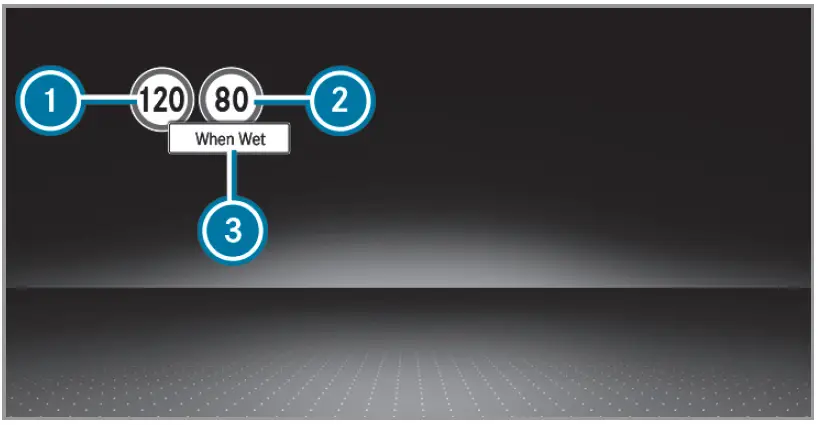
Instrument Display in the Widescreen Cockpit
- Maximum permissible speed
- Maximum permissible speed when there is a restriction
- Additional sign with restriction
- Vehicles with a standard Instrument Display: a + symbol next to a traffic sign in the Instrument Display indicates that additional traffic signs have been detected. These can also be displayed in the media display and optionally in the Head-up Display.
If Traffic Sign Assist cannot determine the maximum permissible speed (e.g. due to missing signs), the following display appears in the Instrument Display:
This is displayed continuously if the vehicle is in a country where Traffic Sign Assist is not supported. Traffic Sign Assist is not available in all countries.
Also, observe the information on display messages in Traffic Sign Assist.
System limits
The system may be impaired or may not function particularly in the following situations:
- If there is poor visibility, e.g. due to insufficient illumination of the road, if there are highly variable shade conditions or in rain, snow, fog or heavy spray.
- If there is glare, e.g. from oncoming traffic, direct sunlight or reflections.
- If the windshield in the area of the multifunction camera is dirty, or if the camera is fogged up, damaged or covered.
- If the traffic signs are hard to detect, e.g. due to dirt or snow, because they are covered, or due to insufficient lighting.
- If the information in the navigation system’s digital map is incorrect or out-of-date.
- If the signs are ambiguous, e.g. traffic signs on construction sites or in adjacent lanes.
- If you turn sharply when passing traffic signs outside the camera’s field of vision.
Setting Traffic Sign Assist
Requirements:
Only vehicles with Driving Assistance Package:
Active Distance Assist DISTRONIC and ECO Assist must be activated for the automatic adoption of speed limits.
Activating or deactivating automatic adoption of speed limits (only vehicles with Driving Assistance Package)
- Select Limit Adoption.
- Activate or deactivate the function.
The speed limits detected by Traffic Sign Assist are automatically adopted by Active Distance Assist DISTRONIC. - If one of the following systems is activated, the detected speed can be manually adopted as the speed limit:
- Active Distance Assist DISTRONIC
- Cruise control
- Variable limiter
Displaying detected traffic signs in the media display
- Select Display in Central Display.
- Activate or deactivate the function.
Setting the type of warning
- Select Visual & Audible, Visual or Off.
Setting the warning threshold
This value determines the speed at which a warning is issued when exceeded.
- Select Warning Threshold.
- Set the desired speed.
Blind Spot Assist and Active Blind Spot Assist with exit warning
Function of Blind Spot Assist and Active Blind Spot Assist with exit warning
Blind Spot Assist and Active Blind Spot Assist use two lateral, rear-facing radar sensors to monitor the area up to 130 ft (40 m) behind and 10 ft (3 m) next to your vehicle.
If a vehicle is detected at speeds above approx‐imately 8 mph (12 km/h) and this vehicle subse‐quently enters the monitoring range directly next to your vehicle, the warning lamp in the outside mirror lights up red.
Permanent status display in the instrument cluster:
 (gray): system is activated but inoperative
(gray): system is activated but inoperative (green): system is activated and operational
(green): system is activated and operational
If a vehicle is detected close to your vehicle and you switch on the turn signal indicator in the cor‐responding direction, a double warning tone sounds and the red warning lamp in the outside mirror flashes. If the turn signal indicator remains switched on, all other detected vehicles are indicated only by the flashing of the red warning lamp.
If you overtake a vehicle quickly, no warning is given.
WARNING
Risk of accident despite Blind Spot Assist
Blind Spot Assist does not react to vehicles approaching and overtaking you at a greatly different speed.
Blind Spot Assist cannot warn drivers in this situation.
Always pay careful attention to the traf‐fic situation and maintain a safe dis‐tance at the side of the vehicle.
Observe the notes on driving systems and your responsibility; you may otherwise fail to recognize dangers.
Exit warning
The exit warning is an additional function of Blind Spot Assist and can warn vehicle occu‐pants about approaching vehicles when leaving the vehicle when stationary.
WARNING
Risk of accident despite exit warning
The exit warning neither reacts to stationary objects nor to vehicles approaching you at a greatly differing speed.
The exit warning cannot warn drivers in these situations.
- Always pay particular attention to the traffic situation when opening the doors and make sure there is sufficient clear‐ance.
If there is a vehicle in the monitoring range, this is indicated in the outside mirror. If a vehicle occupant opens the door on the side with the warning, a warning tone sounds and the warning lamp in the outside mirror starts to flash. This additional function is only available when Blind Spot Assist is active. When the exit warn‐ing is activated, it can warn vehicle occupants for up to three minutes after switching the igni‐tion off. The exit warning is no longer available once the warning lamp in the outside mirror flashes three times. The exit warning is only an aid and not a substitute for the attention of vehicle occupants. The responsibility for opening and closing the doors and for leaving the vehicle remains with the vehi‐cle occupants.
System limits
Blind Spot Assist and Active Blind Spot Assist may be limited in the following situations, in particular:
- If there is dirt on the sensors or the sensors are obscured
- In poor visibility, e.g. due to fog, heavy rain or snow
- If there are narrow vehicles, e.g. bicycles or motorbikes
- If the road has very wide or narrow lanes
- If vehicles are not driving in the middle of their lane
Warnings may be issued in error when driving close to crash barriers or similar continuous lane borders. Always make sure that there is sufficient distance to the side for other traffic or obstacles.
Warnings may be interrupted when driving alongside long vehicles, for example, trucks, for a prolonged time. Blind Spot Assist is not operational when the reverse gear is engaged.
The exit warning may be limited in the following situations:
- When the sensors are covered by adjacent vehicles in narrow parking spaces
- When people approach the vehicle
- In the event of stationary or slowly moving objects
The function of brake application (Active Blind Spot Assist)
If Active Blind Spot Assist detects a risk of a side impact in the monitoring range, a course-cor‐recting brake application is carried out. This is designed to help you avoid a collision.
The course-correcting brake application is available in the speed range between approximately 20 mph (30 km/h) and 125 mph (200 km/h).
WARNING
Risk of accident despite brake application of Active Blind Spot Assist
A course-correcting brake application cannot always prevent a collision.
- Always steer, brake or accelerate your‐ self, especially if Active Blind Spot Assist warns you or makes a course-correcting brake application.
- Always maintain a safe distance at the sides.

If a course-correcting brake application occurs, the red warning lamp flashes in the outside mir‐ror and a warning tone sounds. In addition, a dis‐play 1 indicating the danger of a side collision appears in the multifunction display. In rare cases, the system may make an inappro‐priate brake application. This brake application may be interrupted at any time if you steer slightly in the opposite direction or accelerate.
System limits
Note the system limitations of Active Blind Spot Assist; you may otherwise not recognize the dan‐gers.
Either a course-correcting brake application appropriate to the driving situation, or none at all, may occur in the following situations:
- Vehicles or obstacles, e.g. crash barriers, are located on both sides of your vehicle.
- A vehicle approaches too closely on the side.
- You have adopted a sporty driving style with high cornering speeds.
- You brake or accelerate significantly.
- A driving safety system intervenes, e.g. ESP® or Active Brake Assist.
- ESP® is deactivated.
- A loss of tire pressure or a faulty tire is detected.
Active Lane Keeping Assist
Function of Active Lane Keeping Assist Active
Lane Keeping Assist monitors the area in front of your vehicle by means of the multifunc‐tion camera (/ page 152). It serves to protect you against unintentionally leaving your lane. You will be warned by vibration pulses in the steering wheel and guided by a course-correct‐ing brake application back into your lane. Active Lane Keeping Assist is available in the speed range between 37 mph (60 km/h) and 124 mph (200 km/h). Active Lane Keeping Assist can neither reduce the risk of an accident if you fail to adapt your driving style nor override the laws of physics. It cannot take into account road, weather or traffic conditions. Active Lane Keeping Assist is only an aid. You are responsible for maintaining a safe distance to the vehicle in front, for vehicle speed, for braking in good time and for staying in lane.
The status of Active Lane Keeping Assist is dis‐played in the on-board computer:
 (green): Active Lane Keeping Assist is active and operating.
(green): Active Lane Keeping Assist is active and operating. (gray): Active Lane Keeping Assist is active but not operating.
(gray): Active Lane Keeping Assist is active but not operating. Active Lane Keeping Assist is deactivated or there is a malfunction.
Active Lane Keeping Assist is deactivated or there is a malfunction.
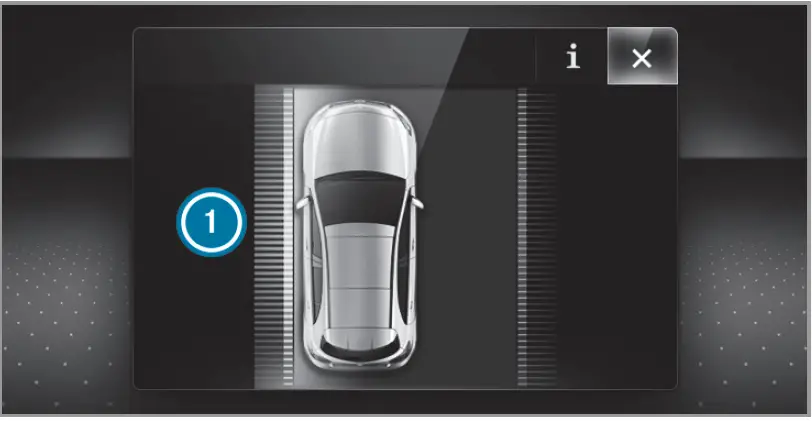
If a lane-correcting brake application occurs, display 1 appears in the multifunction display. The system does not apply the brake if you acti‐vate the turn signal indicator.
Vehicles with Driving Assistance Package: if the system detects an obstacle, such as another vehicle in the adjacent lane, it will apply the brake regardless of the turn signal indicator.
You are warned by vibrations in the steering wheel in the following circumstances:
- Active Lane Keeping Assist detects a lane marking.
- A front wheel drives over this lane marking.
Conditions for a course-correcting brake application (vehicles without Driving Assis‐tance Package)
Lane markings were detected on both sides of the lane. The front wheel drives over a continu‐ous lane marking. A brake application may be interrupted at any time if you steer slightly in the opposite direction.
Conditions for a course-correcting brake application (vehicles with Driving Assistance Package)
- A continuous lane marking was detected and driven over with the front wheel.
- A lane marking and an approaching vehicle, an overtaking vehicle or vehicles driving parallel to your vehicle were detected in the adjacent lane. The front wheel drives over the lane marking.
- A brake application may be interrupted at any time if you steer slightly in the opposite direction.
System limits
No lane-correcting brake application occurs in the following situations:
- You clearly and actively steer, brake or accelerate.
- If a driving safety system intervenes, such as ESP®, Active Brake Assist or Active Blind Spot Assist.
- You have adopted a sporty driving style with high cornering speeds or high rates of acceleration.
- When ESP® is deactivated.
- If a loss of tire pressure or a faulty tire has been detected and displayed.
If you deactivate the Active Lane Keeping Assist warning and the lane markings cannot be clearly detected, it is possible that no lane correcting brake application takes place.
The system may be impaired or may not function particularly in the following situations:
- If there is poor visibility, e.g. due to insufficient illumination of the road, if there are highly variable shade conditions or in rain, snow, fog or heavy spray.
- If there is glare, e.g. from oncoming traffic, the sun or reflections.
- If the windshield in the area of the multifunction camera is dirty, or if the camera is fog‐ged up, damaged or covered.
- If there are no lane markings, or several unclear lane markings are present for one lane, e.g. around roadworks.
- If the lane markings are worn, dark, or covered.
- If the distance from the vehicle in front is too short and thus the lane markings cannot be detected.
- If the lane markings change quickly, e.g. lanes branch off, cross one another or merge.
- If the road is very narrow and winding.
- Vehicles with Driving Assistance Package: if the radar sensors in the rear bumper are dirty or covered in snow and an obstacle is detected in your lane, no lane-correcting brake application takes place.
The function of adaptive damping adjustment
Suspension with adaptive damping adjustment continuously adjusts the characteristics of the suspension dampers to the current operating and driving conditions.
The damping is set individually for each wheel and is affected by the following factors:
- the road surface conditions
- vehicle load
- the drive program selected
- the driving style
The drive program can be adjusted using the DYNAMIC SELECT switch.
Rear view camera
Function of the rear view camera
When you engage reverse gear, the image from the rear view camera is shown in the media dis‐play. Dynamic guide lines show the path the vehicle will take with the current steering angle. This helps you to orient yourself and to avoid obstacles when backing up.
The rear view camera is only an aid. It is not a substitute for your attention to the surroundings. The responsibility for safe maneuvering and parking remains with you. Make sure that there are no persons, animals or objects etc., in the maneuvering area while maneuvering and park‐ing.
% You can open the cover of the rear view camera manually.
The guide lines in the media display show the distances to your vehicle. The distances dis‐played only apply to road level.
Depending on the vehicle equipment, you can select from the following views:
- Normal view
- Wide-angle view
The area behind the vehicle is displayed as a mirror image, as in the inside rearview mirror.
Vehicles without Parking Assist PARKTRONIC
The following camera views are available in the multimedia system: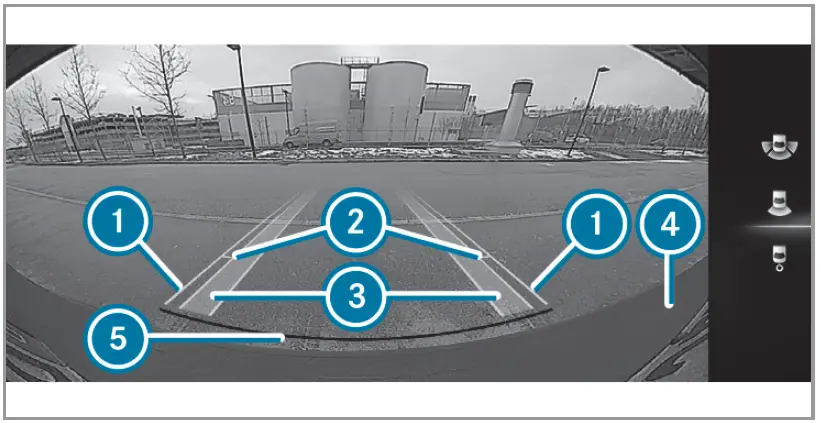
Normal view
- Yellow guide line, vehicle width (driven surface) depending on the current steering angle (dynamic)
- Yellow guideline at a distance of approximately 3.3 ft (1.0 m) from the rear area
- Yellow lanes marking the course the tires will take with the current steering angle (dynamic)
- Bumper
- Red guide line at a distance of approximately 1.0 in (0.3 m) from the rear area
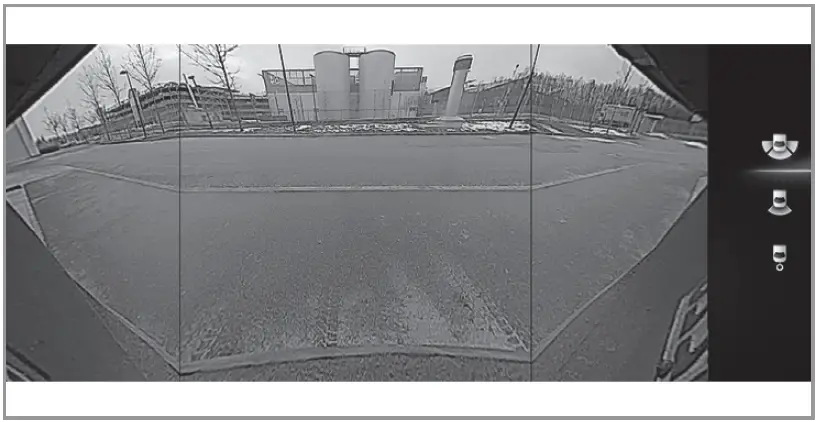
Wide-angle view
Vehicles with Parking Assist PARKTRONIC
The following camera views are available in the multimedia system: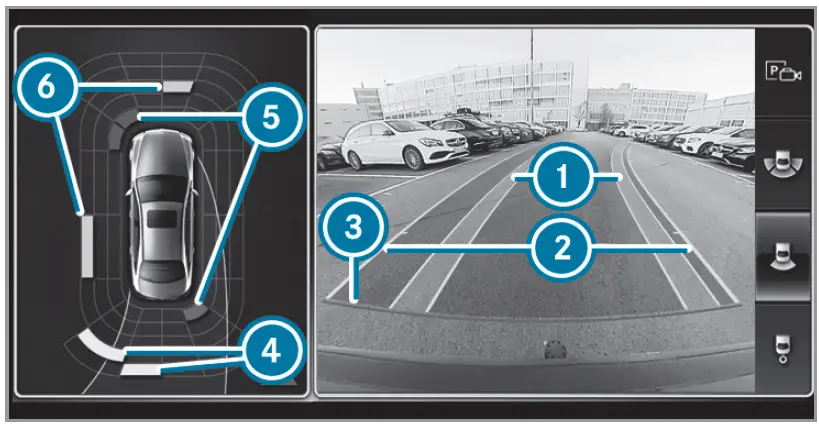
Normal view
- Yellow lanes marking the course the tires will take with the current steering angle (dynamic)
- Yellow guide line, vehicle width (driven surface) depending on the current steering angle (dynamic)
- Red guide line at a distance of approximately 1.0 in (0.3 m) from the rear area
- Yellow warning indicator of Parking Assist PARKTRONIC: obstacles at a distance between approximately 2.0 ft (0.6 m) and 3.3 ft (1.0 m)
- A red warning display of Parking Assist PARKTRONIC: obstacles are very close (approximately 1.0 ft (0.3 m) or less)
- Orange warning display of Parking Assist PARKTRONIC: obstacles are a medium distance away (between approximately 1.0 ft (0.3 m) and 2.0 ft (0.6 m))
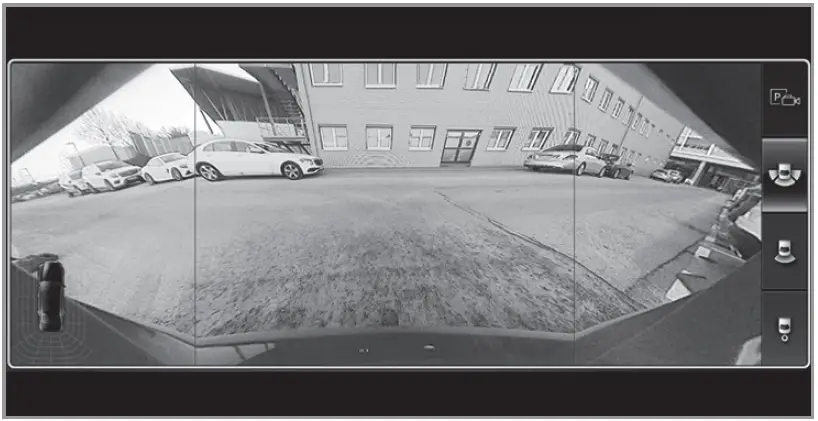
Wide-angle view
System failure
If the rearview camera is not operational, the following display appears in the multimedia system.
System limits
The rear view camera will not function or will only partially function in the following situations:
- The trunk lid is open.
- There is heavy rain, snow or fog.
- The ambient light conditions are poor, e.g. at night.
- Cameras, or vehicle components in which the cameras are installed, are damaged, dirty or covered. Observe the information on vehicle sensors and cameras.
- Do not use the rearview camera in these types of situations. You could otherwise injure others or collide with objects when parking the vehicle.
- The contrast of the display may be impaired by direct sunlight or by other light sources, e.g. when driving out of a garage. In this case, pay particular attention.
- Have the display repaired or replaced if, for example, pixel errors considerably restrict its use
360° camera
The function of the surround view camera
The surround-view camera is a system that consists of four cameras. The cameras cover the immediate vehicle surroundings. The system assists you when you are parking or at exits with reduced visibility, for example. The views of the surround-view camera are always available when driving forward up to a speed of approx. 10 mph (16 km/h) and when backing up.
The surround-view camera is only an aid and may show a distorted view of obstacles, show them incorrectly or not show them at all. It is not a substitute for your attention to the surroundings. The responsibility for safe maneuvering and parking remains with you. Make sure that there are no persons, animals or objects etc., in the maneuvering area while maneuvering and parking.
The system evaluates images from the following cameras:
- Rear view camera
- Front camera
- Two side cameras in the outside mirrors
- You can open the cover of the rear view camera manually.
Views of the surround view camera
You can select from different views: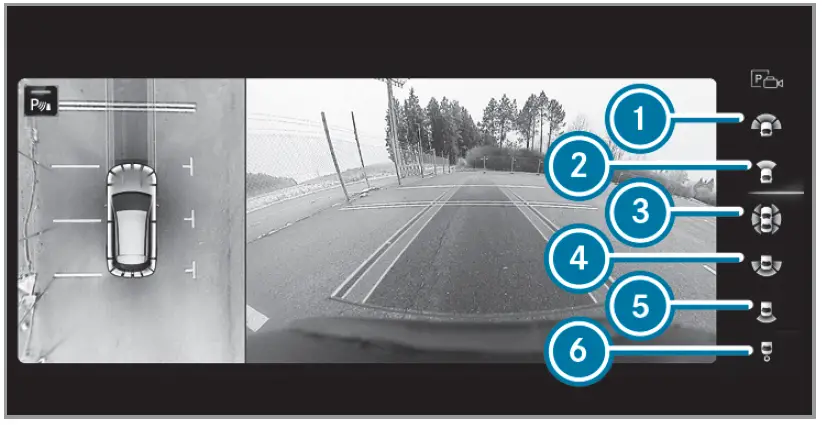
- Wide-angle view, front
- Top view with image from the front camera
- Top view with images from the side cameras in the outside mirrors
- Wide-angle view, rear
- Top view with image from the rear view camera
- Top view with trailer view (vehicles with a trailer hitch)
Top view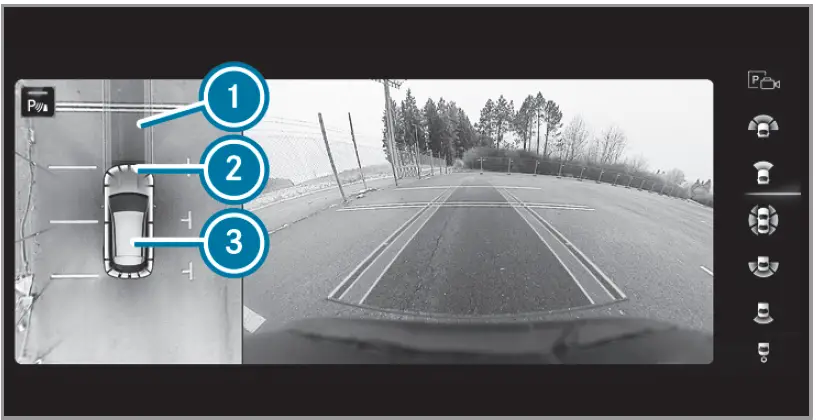
- Lane indicating the route the vehicle will take at the current steering wheel angle
- Warning display of Parking Assist PARKTRONIC
- Your vehicle from above
The color of the individual segments of warning display 2 is based on the distance to the detected obstacle:
- Yellow segments: obstacles at a distance between approx. 2.0 ft (0.6 m) and 3.3 ft (1.0 m)
- Orange segments: obstacles at a distance between approx. 1.0 ft (0.3 m) and 2.0 ft (0.6 m)
- Red segments: obstacles at a very short distance of approx. 1.0 ft (0.3 m) or less
When Parking Assist PARKTRONIC is operational and no object is detected, the segments of the warning display are shown in gray.
Guide lines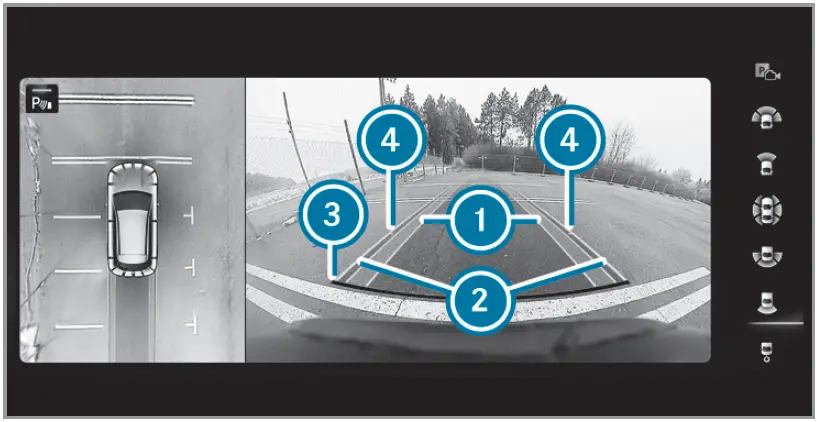
- Yellow lane marking the course the tires will take at the current steering wheel angle (dynamic)
- Yellow guide line, vehicle width (driven surface) depending on the current steering wheel angle (dynamic)
- Red guide line at a distance of approximately 1.0 in (0.3 m) from the rear area
- Mark at a distance of approx. 3.3 ft (1.0 m)
- When Active Parking Assist is active, lane markings 1 are displayed in green.
The guide lines in the media display show the distances to your vehicle. The distances apply to road level.
Side view of the mirror cameras
The sides of the vehicle can be seen in this view.
- Guide line of external vehicle dimensions with outside mirrors folded out
- Marker of the wheel contact points
System failure
If the system is not ready for operation, the following message appears in the media display:
System limits
The surround view camera will not function or will only partially function in the following situations:
- The doors are open.
- The outside mirrors are folded in.
- The trunk lid is open.
- There is heavy rain, snow or fog.
- The ambient light conditions are poor, e.g. at night.
- Cameras, or vehicle components in which the cameras are installed, are damaged, dirty or covered. Observe the information on vehi‐cle sensors and cameras.
- Do not use the surround-view camera under such circumstances. You could otherwise injure others or collide with objects when parking the vehicle.
For technical reasons, the standard height of the vehicle may be altered if the vehicle is carrying a heavy load and can result in inaccuracies in the guide lines and in the display of the generated images.
- The contrast of the display may be impaired by abrupt, direct sunlight or by other light sources, e.g. when driving out of a garage. In this case, pay particular attention.
- Have the display repaired or replaced if, for example, pixel errors considerably restrict its use.
See the notes on cleaning the surround view camera.
Calling up the view of the surround view camera using the reverse gear
- Shift to reverse gear.
- Select the desired view in the multimedia system.
- If, after shifting to reverse gear, the image of the rearview camera is not shown: switch off the ignition, press and hold thec button, switch on the ignition and engage reverse gear again.
Parking Assist PARKTRONIC
Function of Parking Assist PARKTRONIC
Parking Assist PARKTRONIC is an electronic parking assistance system with ultrasound. It monitors the area around your vehicle using mul‐tiple sensors on the front bumper and on the rear bumper. Parking Assist PARKTRONIC shows you the distance between your vehicle and a detected obstacle visually and audibly. Parking Assist PARKTRONIC is only an aid. It is not a substitute for your attention to the sur‐roundings. The responsibility for safe maneuver‐ing and parking remains with you. Make sure that there are no persons, animals or objects in the maneuvering area while maneuvering and parking in/exiting parking spaces. In the standard setting, an intermittent warning tone sounds from a distance of approximately 1.0 ft (0.3 m) to an obstacle in front and approx‐imately 3.3 ft (1.0 m) to an obstacle behind. A continuous warning tone sounds from a distance of approximately 0.7 ft (0.2 m). Using the Warn Early All Around setting in the multimedia sys‐tem, the warning tones for front and side impact protection can be set to sound at a greater dis‐tance of approximately 3.3 ft (1.0 m) in front and 2.0 ft (0.6 m) on the sides. The Warn Early All Around setting is always active at the rear of the vehicle.
Parking Assist PARKTRONIC display in the multimedia system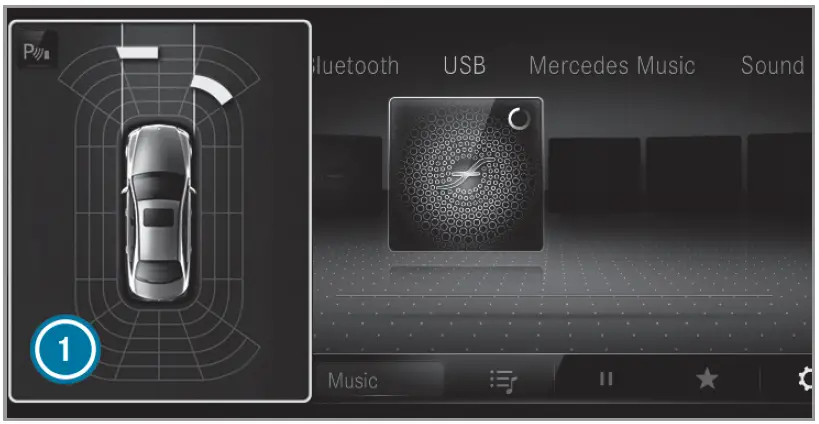
Vehicles without surround view camera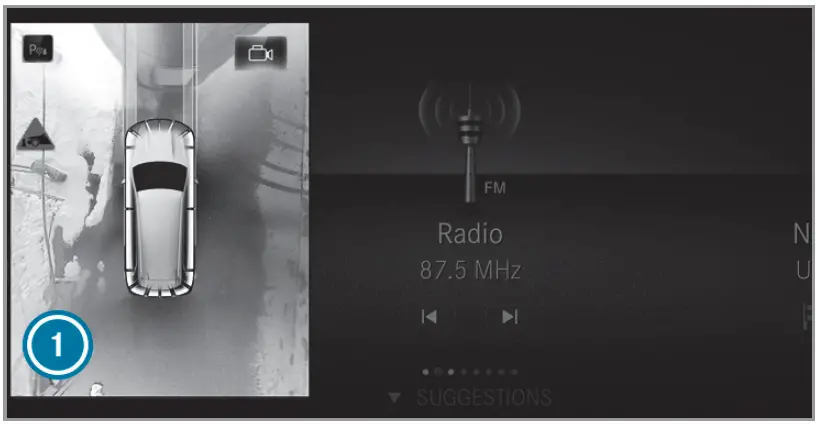
Vehicles with surround view camera
If you have not selected the Camera & Parking menu and an obstacle is detected in the path of the vehicle, a pop-up window for Parking Assist PARKTRONIC 1 appears in the multimedia sys‐tem at speeds below 6 mph (10 km/h). The color of the individual segments of the warn‐ing display is based on the distance to the detec‐ted obstacle:
- Yellow segments: obstacles at a distance between approx. 2.0 ft (0.6 m) and 3.3 ft (1.0 m)
- Orange segments: obstacles at a distance between approx. 1.0 ft (0.3 m) and 2.0 ft (0.6 m)
- Red segments: obstacles at a very short distance of approx. 1.0 ft (0.3 m) or less
Display of Parking Assist PARKTRONIC in the Head-up Display
Optionally, obstacles detected by Parking Assist PARKTRONIC from a distance of approximately 3.3 ft (1.0 m) in front 2 and 2.0 ft (0.6 m) on sides 3 can also be displayed in the Head-up Display.
System limits
Parking Assist PARKTRONIC does not necessarily take into account the following obstacles:
- Obstacles below the detection range, e.g. persons, animals or objects.
- Obstacles above the detection range, e.g. overhanging loads, overhangs or loading ramps of trucks.
The sensors must be free of dirt, ice and slush. Otherwise, they may not function correctly. Clean the sensors regularly, taking care not to scratch or damage them.
Problems with Parking Assist PARKTRONIC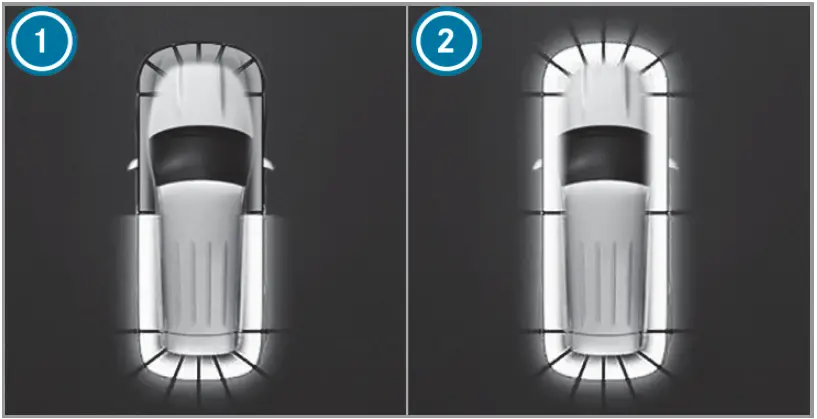
Example: vehicles with a surround-view camera
When rear segments 1 or all-around segments 2 light up red and the ![]() symbol appears in the multifunction display, Parking Assist PARKTRONIC may have been deactivated due to signal interference. Start the vehicle again and check if Parking Assist PARKTRONIC is working at a different location.
symbol appears in the multifunction display, Parking Assist PARKTRONIC may have been deactivated due to signal interference. Start the vehicle again and check if Parking Assist PARKTRONIC is working at a different location.
If a warning tone also sounds for approximately two seconds every time the vehicle is started, it may be due to one of the following causes:
- The sensors are dirty: clean the sensors and observe the notes on care of vehicle parts.
- Parking Assist PARKTRONIC has been deactivated due to a malfunction: restart the vehicle. If the problem persists, consult a qualified specialist workshop.
Function of the passive side impact protec‐tion
Passive side impact protection is an additional Parking Assist PARKTRONIC function which warns the driver about obstacles at the side of the vehicle. A warning is issued when obstacles are detected between the front and rear detec‐tion range. In order for an object on the side to be detected, the sensors in the front and rear bumper must first detect the object while you are driving past it.
During the parking procedure or when maneu‐vering, objects are detected as the vehicle drives past. If you steer in the direction of a detected obstacle and there is a risk of a lateral collision, a warning is issued and the segments light up in color in the display.
The segment color changes depending on the distance to the detected obstacle:
- Yellow: approximately 1.0 – 2.0 ft (30 – 60 cm)
- Red: less than approximately 1.0 ft (30 cm)
In order for lateral front or rear segments to be displayed, the vehicle must first travel a distance of at least half of the vehicle length. Once the vehicle has traveled the length of the vehicle, all of the lateral front and rear segments can be displayed.
Parking Assist PARKTRONIC display: vehicles without a surround-view camera
- Operational front and rear
- Operational front, rear and sides
- Obstacle detected at the front right (yellow) and rear (red)
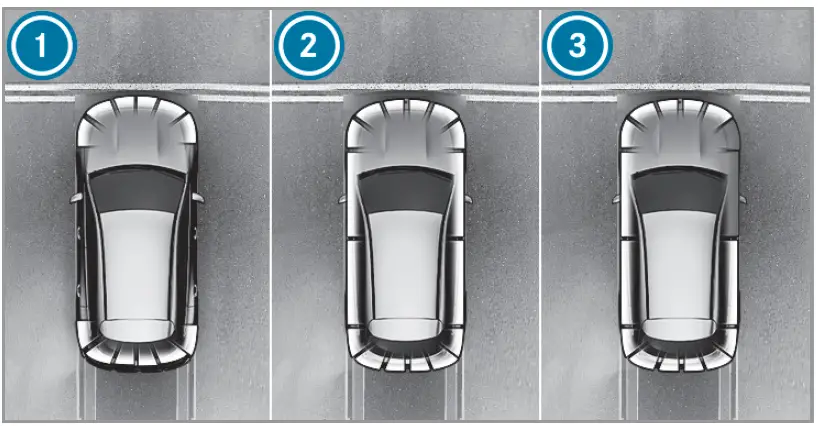
Parking Assist PARKTRONIC display: vehicles with a surround-view camera
- Operational front and rear
- Operational front, rear and sides
- Obstacles detected at the front right (red)
Saved obstacles on the sides are deleted in the following situations, for example:
- You park the vehicle and switch off the ignition.
- You open the doors.
After the engine is restarted, obstacles on the sides must be detected again before a new warning can be issued.
System limits
The system limits for Parking Assist PARKTRONIC apply to passive side impact protection.
The following objects are not detected, for example:
- Pedestrians who approach the vehicle from the side
- Objects placed next to the vehicle
Activating/deactivating Parking Assist PARKTRONIC using the multimedia system
NOTE
Risk of an accident from objects at close range
Parking Assist PARKTRONIC may not detect certain objects at close range.
When parking or maneuvering the vehicle, pay particular attention to any objects which are above or below the sensors, e.g. flower pots or drawbars. The vehicle or other objects could oth‐erwise be damaged.
Requirements:
- The camera menu is open.
- Or: Active Parking Assist is active.
- Or: the PARKTRONIC pop-up window appears.
- Tap
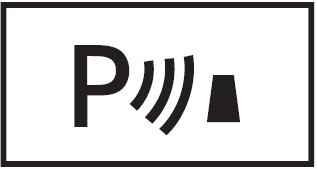 in the media display.
in the media display.
If the indicator lamp is lit, Parking Assist PARKTRONIC is active. If the indicator lamp is not lit or the symbol appears in the instrument cluster, Parking Assist PARKTRONIC is not active.
symbol appears in the instrument cluster, Parking Assist PARKTRONIC is not active. - Parking Assist PARKTRONIC is automatically activated when the vehicle is started.
Alternatively, Parking Assist PARKTRONIC can be activated or deactivated in the quick access menu.
Adjusting the volume of the warning tones
- Select Warning Tone Volume.
- Set a value.
Adjusting the pitch of the warning tones
- Select Warning Tone Pitch.
- Set a value.
Specifying the starting point for the warning tones
You can specify whether the Parking Assist PARKTRONIC warning tones should commence when the vehicle is further away from an obsta‐cle.
- Select Warn Early All Around.
- Activate or deactivate the function.
Activating/deactivating audio fadeout
You can specify whether the volume of a media source in the multimedia system is to be reduced when Parking Assist PARKTRONIC sounds a warning tone.
- Select Audio Fadeout During Warning Tones.
- Activate or deactivate the function.
Active Parking Assist
Function of Active Parking Assist
Active Parking Assist is an electronic parking assistance system, which uses ultrasound with the assistance of the rear view camera and sur‐round view camera. When you are driving for‐wards up to approximately 22 mph (35 km/h), the system automatically measures parking spaces on both sides of the vehicle.
Active Parking Assist offers the following functions:
- Parking in parking spaces parallel to the road
- Parking in parking spaces perpendicular to the road (optionally either forwards or reverse)
- R Exiting parking spaces if you have parked using Active Parking Assist
As soon as all requirements are met for searching for parking spaces, the ![]() display appears in the multifunction display.
display appears in the multifunction display.
When Active Parking Assist has detected parking spaces, the![]() display appears in the multi‐function display. The arrows show on which side of the road detected parking spaces are located. They are then shown in the media display. The parking space can be selected as desired. Depending on the location of the parking space, the parking direction (rearwards or forwards) can also be selected as desired.
display appears in the multi‐function display. The arrows show on which side of the road detected parking spaces are located. They are then shown in the media display. The parking space can be selected as desired. Depending on the location of the parking space, the parking direction (rearwards or forwards) can also be selected as desired.
When Active Parking Assist is activated, the turn signal indicators are activated based on the calculated path of your vehicle. When you are entering or exiting a parking space, the procedure is assisted by acceleration, braking, steering and gear changes. Active Parking Assist is only an aid. It is not a substitute for your attention to the surroundings. The responsibility for safe maneuvering and parking remains with you. Make sure that no persons, animals or objects etc. are in the maneuvering range.
Active Parking Assist will be canceled in the fol‐lowing situations:
- Parking Assist PARKTRONIC is deactivated.
- You begin steering.
- You apply the parking brake.
- Vehicles with automatic transmission: you engage transmission position j.
- ESP® intervenes.
- You open the doors or the trunk lid while driving.
System limits
If the exterior lighting is malfunctioning, Active Parking Assist is not available.
Objects located above or below the detection range of the sensors, e.g. overhanging loads, overhangs or loading ramps of trucks, or the bor‐ders of parking spaces, are not detected during measurement of the parking space. These are also then not taken into account when calculating the parking procedure. In some circumstances, Active Parking Assist may therefore guide you into the parking space incorrectly.
WARNING
Risk of accident due to objects located above or below the detection range of Active Parking Assist
If there are objects above or below the detection range, the following situations may arise:
- Active Parking Assist may steer too early.
- The vehicle may not stop in front of these objects.
This could cause a collision.
In these situations, do not use Active Parking Assist.
Extreme weather conditions, such as snow or heavy rain, may lead to a parking space being measured inaccurately. Parking spaces that are partially occupied by trailer drawbars might not be identified as such or be measured incorrectly. Only use Active Parking Assist on level, high-grip ground.
Do not use Active Parking Assist in the following situations:
- In extreme weather conditions such as ice, packed snow or in heavy rain.
- When transporting a load that protrudes beyond the vehicle.
- On steep uphill or downhill gradients of more than approximately 15%.
- When snow chains are installed.
- Directly after a tire change or when spare tires are installed.
- If the tire pressure is too low or too high. R If the suspension is out of alignment, e.g. after bottoming out on a curb.
Active Parking Assist may also display parking spaces that are not suitable for parking, such as:
- Parking spaces where parking is prohibited.
- Parking spaces on unsuitable surfaces.
Parking with Active Parking Assist
Depending on the vehicle’s equipment, the button may also be located at a different position on the center console.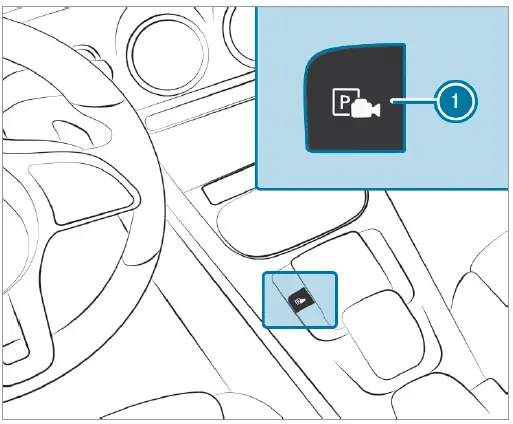
Press button 1.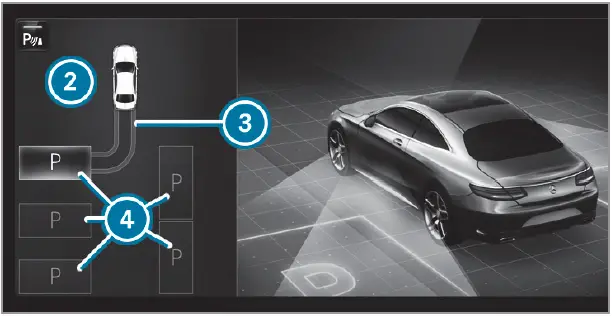
The media display shows the view of Active Park‐ing Assist. Area 2 displays detected parking spaces 4 and vehicle path 3.
- Vehicle path 3 shown on the media display may differ from the actual vehicle path.
- If a parking space is displayed: stop the vehicle.
- Select desired parking space 4 and confirm.
- If necessary, select the parking direction (forwards or reverse), and confirm.
Vehicle path 3 is shown, depending on selected parking space 4 and the parking direction. - The turn signal indicator is switched on automatically when the parking procedure begins.
You are responsible for selecting the turn signal indicator in accordance with the traffic conditions. If necessary, select the turn signal indicator accordingly.
WARNING
Risk of accident due to vehicle swinging out while parking or pulling out of a parking space
While parking or exiting a parking space, the vehicle swings out and can drive onto areas of the oncoming lane.
This could cause you to collide with objects or other road users.
- Pay attention to objects and other road users.
Where necessary, stop the vehicle or cancel the parking procedure with Active Parking Assist. - If, for example, the Please Engage Reverse Gear message appears in the media display: select the corresponding transmission position.
Vehicles with automatic transmission:
The vehicle drives into the selected parking space. - During the parking procedure with Active Parking Assist, the lane markings are displayed in green in the camera image.
On completion of the parking procedure, the Parking Assist Finished, Take Control of Vehicle display message appears. Further maneuvering may still be necessary.
- After completion of the parking procedure, safeguard the vehicle against rolling away. When required by legal requirements or local conditions: turn the wheels towards the curb.
- You can stop the vehicle and change the transmission position during the parking procedure. The system then calculates a new vehicle path. If no new vehicle path is available, the system can change the transmission position again or cancel the parking procedure.
Exiting a parking space with Active Parking Assist
Requirements:
- The vehicle has been parked with Active Parking Assist.
- Depending on the vehicle’s equipment, the button may also be located at a different position on the center console.
Please note that you are responsible for the vehicle and surroundings during the entire parking procedure.
- Start the vehicle.
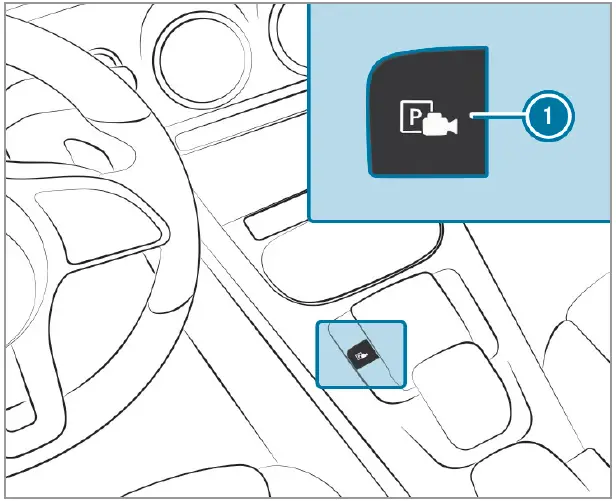
- Press button 1.
The media display shows the view of Active Parking Assist.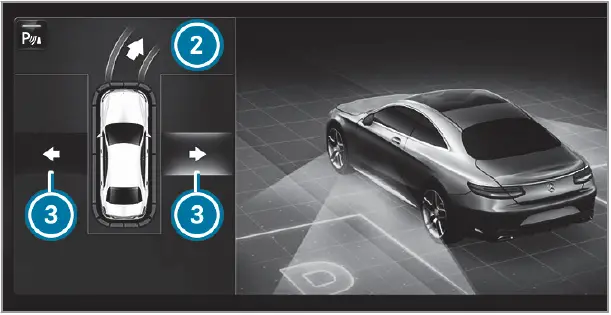
- If the vehicle has been parked perpendicular to the direction of travel: in area 2, select direction of travel 3 Left or Right.
- The vehicle path shown on the media display may differ from the actual vehicle path.
- Confirm the direction of exit 3 to drive out of the parking space.
- The turn signal indicator is switched on automatically when the exiting procedure begins.
You are responsible for selecting the turn signal indicator in accordance with the traffic conditions. If necessary, select the turn signal indicator accordingly.
WARNING
Risk of accident due to vehicle swinging out while parking or pulling out of a parking space
While parking or exiting a parking space, the vehicle swings out and can drive onto areas of the oncoming lane.
This could cause you to collide with objects or other road users
- Pay attention to objects and other road users.
- Where necessary, stop the vehicle or cancel the parking procedure with Active Parking Assist.
- If, for example, the Please Engage Forward Gear message appears in the media display: select the corresponding transmission position.
The vehicle moves out of the parking space. The turn signal indicator is switched off automatically.
After the parking space has been exited, a warning tone and the ![]() Parking Assist Finished, Take Control of Vehicle message prompt you to take control of the vehicle.
Parking Assist Finished, Take Control of Vehicle message prompt you to take control of the vehicle.
The vehicle is not automatically braked and can roll away. You have to accelerate, brake, steer and change gear yourself again.
Maneuvering assistance
The function of Drive Away Assist
Drive Away Assist can reduce the severity of an impact when pulling away. If an obstacle is detected in the direction of travel, the vehicle’s speed is briefly reduced to approx. 1 mph
(2 km/h). If a critical situation is detected, the É symbol appears in the media display. You can cancel an intervention by Drive Away Assist at any time by deactivating Parking Assist PARKTRONIC.
Drive Away Assist cannot always clearly identify objects and traffic situations.
- Always pay careful attention to the traffic situation; do not rely on Drive Away Assist alone.
- Be prepared to brake or swerve as necessary, provided the traffic situation permits and that it is safe to take evasive action.
Drive Away Assist is only an aid. It is not a sub‐stitute for your attention to the surroundings. The responsibility for safe maneuvering and parking remains with you. Make sure that no persons, animals or objects, etc. are in the maneuvering range.
The risk of a collision may arise in the following situations, for example:
- If the accelerator and brake pedals are mixed up.
- If an incorrect transmission position is engaged.
Drive Away Assist is active under the following conditions:
- If Parking Assist PARKTRONIC is activated.
- If you shift the transmission position to k or h when the vehicle is stationary.
- If the detected obstacle is less than approx. 3.3 ft (1.0 m) away.
- If the maneuvering assistance function is activated in the multimedia system.
System limits
The performance of Drive Away Assist is limited on inclines.
Also, observe the system limits of Parking Assist PARKTRONIC.
The function of Cross Traffic Alert
Cross Traffic Alert is only available for vehicles with Blind Spot Assist or Active Blind Spot Assist.
Cross Traffic Alert can warn drivers of any cross‐ing traffic when backing up and maneuvering out of a parking space. The radar sensors in the bumper also monitor the area adjacent to the vehicle. If a critical situation is detected, the L symbol appears in the media display and the vehicle can be braked automatically. If the radar sensors are obstructed by vehicles or other objects, detection is not possible.
Cross Traffic Alert is active under the following conditions:
- If the vehicle is backing up at a walking pace.
- Maneuvering assistance is activated.
- Also, observe the instructions on Blind Spot Assist and Active Blind Spot Assist.
Vehicle towing instructions
The vehicle is not suitable for the use of tow bar systems that are used for flat towing or dinghy towing, for example. Attaching and using tow bar systems can lead to damage to the vehicle. When you are towing a vehicle with tow bar systems, safe driving characteristics cannot be guaranteed for the towing vehicle or the towed vehicle. The vehicle-trailer combination may swerve from side to side. Comply with the permitted towing methods and the instructions for towing with both axles on the ground.
FAQs
The 7-speed dual-clutch automatic transmission is standard on the A-Class Sedan.
To increase traction and handling, the A-Class Sedan has a 4MATIC all-wheel-drive system that is optional.
Typically, the 2021 A-Class Sedan provides a variety of turbocharged four-cylinder engines with various power outputs.
The A-Class Sedan is made with latest engine technologies and aerodynamic elements, therefore it is designed to be fuel-efficient.
The A-Class Sedan is outfitted with cutting-edge safety features.
A rearview camera, which facilitates parking and maneuvering, is a standard feature of the 2021 A-Class Sedan.
In order to help with parking and avoid impediments, the A-Class Sedan often comes with front and rear parking sensors.
A possible automatic parking technology for the 2021 A-Class Sedan would make parallel parking simpler.
The A-Class Sedan’s turning radius is normally approximately 36 feet, which is rather small and improves mobility.
The A-Class Sedan has a cruise control feature to help drivers keep their speed constant on the highway.
You may choose from a variety of driving modes, including Comfort, Sport, and Eco, on the A-Class Sedan, depending on your preferences.
Lane-keeping assist, which helps you stay in your lane on the highway, is normally featured in the safety package of the 2021 A-Class Sedan.
Typically, the A-Class Sedan does include automated emergency braking, which can assist reduce.
The trunk of the A-Class Sedan is a reasonable size, offering enough room for daily bags and food.
Yes, the hill start assist feature of the A-Class Sedan frequently protects the vehicle from rolling backward when it starts on an uphill.
Useful Links
Download Manuals: Owner’s Manuals | Mercedes-Benz USA
View Full Manual: Mercedes-Benz A-CLASS SEDAN 2021 User Manual


